
Title: The Art and the Romance of Indian Basketry
Author: Clark Field
Release date: May 30, 2020 [eBook #62285]
Most recently updated: October 18, 2024
Language: English
Credits: Produced by Stephen Hutcheson and the Online Distributed
Proofreading Team at https://www.pgdp.net

clark field
clark field collection
philbrook art center tulsa 1964
Published by Philbrook Art Center
Tulsa, Oklahoma
1964
The autobiographical information about Mr. Clark Field, which appears at the end of this brochure, briefly tells the inspiring story of well over four decades of dedication to—and sincere belief in—the American Indian as a creative artist. The results of these many years of collecting Indian baskets (and pottery) are on permanent display at Philbrook Art Center, in the Clark Field Collection; in addition, many other specimens are in storage and available to the scholar in the study collection. This brochure is not intended as a catalogue of all of the baskets in the Clark Field Collection, which includes more than a thousand specimens. Rather, it serves as an introduction to Indian basketry and tells the story of how baskets were made and used. About 90 of the more important baskets are illustrated, including the most famous American Indian basket, woven by Dotsolalee reproduced in color on the cover.
Mr. Field has combined his enthusiasm for the art of Indian basketry with a high degree of scientific scholarship. He has kept careful records, which will become increasingly valuable as old specimens become even more rare and this Indian skill gradually dies out in this modern world. His daughter, Dorothy Field Maxwell, has assisted Mr. and Mrs. Field in their collection and with the preparation of this brochure. Mrs. Jeanne Snodgrass, Curator of Indian Art at Philbrook, has also assisted with the brochure in an editorial capacity.
Mr. Field has performed an invaluable service to humanity in his long dedication to the preservation of this most important facet of the original Americans, and Philbrook Art Center will be, for countless generations, a mecca for those who wish to enjoy this fascinating utilitarian, yet esthetically meaningful art form.
Donald G. Humphrey Director Philbrook Art Center Clark Field
The need for food containers in early human communities led to the “invention” of basketry. The first baskets may have been made of animal skin or twigs; but soon evolved into the use of more suitable materials such as vegetable fibres. Because of the organic materials used in making baskets, most of the earliest examples have been lost through decay. A few examples have been preserved but only in areas of extremely dry climate, such as in Egypt, in Chile and Peru in South America, and in the southwestern United States. Radiocarbon tests of woven artifacts establish the existence and the use of baskets in Nevada, Utah and Oregon as early as 9000 to 700 B.C., and that Egyptians of the pre-dynastic period (c. 5000 B.C.) used baskets. Early literary sources, such as the Bible, mention baskets and other woven articles such as the “ark of bulrushes” in which the infant Moses was hidden (Exod. 2: 3, 53); baskets were used to bring the tithes to the temple, and Matthew talked of “twelve baskets full.” (Matt. 14: 20.)
In the study of American Indian baskets there are three major factors to be considered: the first is the tribe which produced the basket; the second is the language, since inter-marriage among tribes produced varying cultures; the third factor is the weave of the basket itself. For example, the five major weaves used by American Indians are: Coil, Twine, Twill, Wicker and Imbricated. To the novice there is the obvious difference in shape, color and texture of a collection of Indian baskets viewed in a museum. To the collector there is the hint of the whole pattern of life of the Indians who produced the basket.
The materials used in any particular basket reflect the locale of the tribe which produced it, for the Indian used materials that were at hand. In the case of the Cherokees, a native variety of red honey suckle produced runners that were used by that tribe in Virginia in a wicker-type weave. In North Carolina, the same tribe utilized the Japanese honeysuckle, while in Oklahoma the tribe used buckbrush runners. In Arizona, the Pimas wove split willow twigs and the black Martyna or “Devil’s Claw” of their desert lands.
It is the Indian woman, not the man, who makes baskets (except for few instances, i.e., the Papago carrying basket). They are made either for utilitarian use or for ceremonial use. Basket designs are not taught to the craftsman nor are they copied from a pattern book. They are created by the individual weaver who is an artist of great ability. The artist-craftsman must first develop a manner of weaving that will form a shape adequate for the basket’s final use. She must then find suitable materials in her area for this weaving project. This step completed, she mentally creates a decorative design and invents a method of weaving it into the basket.
It is known that all North American Indian tribes, at some time in their history, made and used baskets. However, the finest and most decorative baskets were made about the middle of the 19th century, in the Northwest, down the Pacific Coast states and into the Southwest through Arizona and New Mexico.
In 1935 there were more than five hundred Pima Indians making baskets for their own use. Now there are less than six good weavers on that reservation. Today Papago Indians make some baskets for tourist trade, but not nearly as many as they made a few years ago. The Hopi Indians bring a few baskets to market places, but there are fewer and fewer each year. For example: at the 1964 Inter-Tribal Indian Ceremonials, Gallup, New Mexico, there were forty classifications in the basketry competition—baskets were submitted to only twenty-seven classifications. There are some basket weavers among other tribes but for the most part, few tribes today may be called “basket makers.”
The influence of other culture groups upon the craft of basket weaving is so great that each year fewer baskets are produced by the regular weavers. The Indian women have learned that they can secure mass produced articles as a substitute for baskets. Only two percent of the types of baskets included in this collection are now being made. It is quite probable that by the year 2000 there will be NO Indian baskets being woven.
Very few people are aware that baskets were made by the Ozark “Bluff Dwellers.” A special exhibit in the University of Arkansas Museum, Fayetteville, contains a small basket filled with grasshoppers. The University Museum points out that as long ago as the year 1 A.D., baskets were being made by Indians in the Ozark Area. This provides further evidence of the Indian’s early inhabitance of this country.
Case No. 5:
These tightly woven baskets made by Thlinkits of Alaska, were woven from spruce tree roots which were split by hand. The baskets were used to hold boiling water for clam cooking. The fibers swelled to such an extent that water could be retained in the basket for as long as five hours. Today this tribe purchases a kettle or bucket for their boiling needs. (See Plate 9c)
Case No. 7:
These large Apache baskets used for storing grain, were made about 1874. It required as long as three months to produce this type of specimen and since 1914 very few have been made. The twenty-five cent burlap sack has replaced it. (See Plate 6c)
Case No. 9:
This Cochiti bird cage, made of a yucca plant, has been replaced by metal bird cages.
The Anglo appropriated many Indian basket ideas for his own use:
The Penobscot colander was found in use as such among the people of this Maine tribe and was made about 1841. It is quite possible that we took this as a pattern for our own metal colanders. (See Plate 10a)
It is also quite possible that we copied the pattern of the Catawba, North Carolina, fish trap for our own minnow trap. (See Plate 4a)
The average weaver does not use more than five or six figures in a design.
Case No. 3: Mission of California—a quail and flying duck design. (See Plate 11b)
Case No. 3: Shoshone (Panamint), Death Valley California—Oriole design food bowl. (See Plate 11c)
Case No. 9: Choctaw of Oklahoma—Wall Pocket. (See Plate 16c)
Case No. 9: Niantic of Connecticut—clothes rinsing basket. (See Plate 19d)
Case No. 10: Chitimacha of Louisiana—an alligator intestine design. (See Plate 15c)
Case No. 11: Shoshone (Panamint), Death Valley, California—seventy figures in the design; including the American Eagle, crow in a tree, rocky mountain sheep, and lizard tracks in the sand. (See Plate 6b)
Case No. 11: Quinault of Washington—Clam gathering basket. (See Plate 14b)
Case No. 12: Cahuilla of California—food platter rattlesnake design. (See Plate 12a)
Case No. 12: Chemehueve of Arizona—a “stink bug” design. (See Plate 12c)
Case No. 12: Yavapai Apache of Arizona—a tarantula design. (See Plate 12d)
Case No. 13: Paiute of Nevada—porridge bowl. (See Plate 10b)
Case No. 13: Hoopa of California—grinding tray and stone. (See Plate 10d)
The vanishing Indian? He is not vanishing! In 1890, the Indian population in North America numbered about one quarter million and in 1963, records reveal there are over one million Indians.
There is the mistaken idea that one tribe “understands” the designs of another tribe and that there is symbolism, or meaning, to every design. Actually, most designs are purely decorative renderings and they have no more symbolism for the Indian than a fabric design has for the general public.
The identification of a basket is made not through the interpretation of a “mysterious meaning” of the design but generally from the design motif itself. For instance, baskets made by tribes of southern California are distinguishable to the trained eye since they tend to be of a particularly heavy, bold and angular style. They seldom have mysterious meanings! (See Plate 12b)
Case No. 13:
At one time it was not difficult to identify Apache Basketry by tribal name, such as: San Carlos, Chiricahua, Tonto, and Yavapai. Today it is not possible to identify baskets as belonging to a particular Apache tribe.
During the nineteenth century these southwest tribes waged continual warfare with the Anglos and Spaniards who had settled in the area. Attempts were made by the United States government to establish treaties. However, newly written treaties were broken before the ink dried! About 1880, the army rounded up all the Apaches of Arizona and New Mexico and took them as prisoners to the San Carlos Reservation. There they remained confined for several years. During this period of confinement the basket weavers copied designs and weaving techniques from one another.
When the tribes were released and allowed to return to their respective reservations the “new” styles of basketry were continued. As a result of this situation, today we find baskets woven by these tribes to be so similar in appearance that definite tribal affiliation cannot be determined. They are therefore classified only as Western Apache baskets. (See Plate 13a)
Case No. 3:
This basket was made by Dabuda (Young Willow). She was later given the nick-name of Datsolalee (Broad in the Hips) and is best known by this name since later in life she tipped the scales at 350 pounds.
On March 26, 1917, Datsolalee started weaving this specimen which is fifty-two inches in circumference and has more than 100,000 stitches (more than thirty to the inch). Eleven months later, on February 16, 1918, she completed this basket which is her greatest masterpiece. Although made for ceremonial use, the shape is that of a food bowl. The white background is made of peeled twig from the Mountain Willow; the black color is the root of a Bracken, or giant fern; the reddish-brown is bark from the Nevada Redbud. To her the design meant: We assemble to discuss the happy lives of our ancestors. Shortly after the completion of this basket the weaver lost her eyesight. She died at the age of 95 in 1926.
In 1958 the U. S. Indian Arts and Crafts Board, Department of the Interior, Washington, D.C., rated this basket as probably the finest specimen of basketry ever produced.
During her lifetime, Datsolalee made only forty-six large scale baskets. During the summer months she could often be found at the resort area of Lake Tahoe, California, weaving miniature basketry which she sold to tourists for small sums. In 1914, Mrs. Henrietta K. Burton, from the Bureau of Indian Affairs in Washington, D.C., visited the artist’s home in Carson City, Nevada. Mrs. Burton made numerous photographs of Datsolalee and her baskets for use in federal publications which dealt with Indian basketry. Since that time these photos have appeared in many other basketry publications.
Due to the artist’s reputation and ability, as well as the artistry and craftsmanship of this specimen it is valued at $2000. It is doubtful such a basket could ever again be produced—no weaver today shows ability such as that of Datsolalee. Her baskets are sought by collectors throughout the world.
In 1914, G. A. Steiner, of Pittsburgh, Pennsylvania, purchased the finest basket the artist had produced up to that time. It is forty-nine inches in circumference and has more than eighty thousand stitches. It was purchased for $1950, and added to the Carnegie Library Collection in Pittsburgh (this was the highest price ever paid for a single Indian basket).
Philbrook’s Datsolalee basket has received international recognition. It may be seen, in color, in Indian Art in America, by Frederick J. Dockstader (New York Graphic Society, 1960) and in the magazine America (No. 67) which was distributed by the U. S. Information Agency and printed in Russian. (See Plate 17a)
Case No. 4:
This basket is made of ash splints and is white on the interior. The exterior is decorated with designs painted in native dyes using a swabbing stick which has been pounded at one end to form a brush.
This earliest known type of painted-on decoration ceased about 1870. An approximate dating for this specimen can be established from an April 2, 1835, copy of the Boston Daily Courier, which lines the basket lid. (See Plate 2d)
Case No. 4:
This very plain basket, constructed of brown ash splints, was authenticated by the late Frank G. Speck, internationally known University of Pennsylvania anthropologist, as being Wampanoag.
The Wampanoags, now extinct, were a branch of the Massachusetts Algonquins.
This specimen was made by a direct descendant of King Massasoit, the Indian chief who met the Puritans at their Plymouth Rock landing in 1621. Massasoit was the father of King Phillip, for whom the King Phillip’s Indian Wars of 1676, were named. (See Plate 2c)
Case No. 4:
Annually, in July when the fruit of the Saguaro Cactus is ripe, the Papagos hold their Nahwehteete (wine drinking) ceremony. The purpose of this ceremony is to offer a prayer of supplication to bring rain. Wine, made from the Saguaro (called Tizwin) is passed around in this basket and served from a gourd dipper.
Between dances the basket is used for storing the sacred ceremonial paraphernalia used in the dance. The “Keeper of the Sacred Basket” seldom ever parts with the basket. Therefore, not many can be found in public or private collections. (See Plate 17b)
Case No. 3:
The Pomo Indians are the only tribe known to have completely and fully decorated baskets with feathers. These baskets were considered to be the tribe’s highest artistic achievement. It was a great honor to the memory of a deceased person when this type of basket, especially made for such an occasion, was placed on his body at the cremation ceremony. It may be said that the sacrifice of these baskets was the tribe’s most profound means of showing respect at the time of cremation.
The custom of making and using these baskets no longer prevails. Few people today know the art, and even fewer people are willing to devote the nearly two years to make one feathered basket.
At the time this ceremony was active in the Pomo culture, each family had several such baskets in reserve. It must therefore be assumed that the women of the tribe devoted a great deal of their time producing these symbols to honor the dead.
It is interesting to compare cultures: The Pomo Indian sacrificed a work of art which took about two years to make—today’s Anglo society calls the florist and orders a “ten dollar spray” of flowers. This basket on the collector’s market is valued at about $300. (See Plate 18c & 18d)
Case No. 4:
The “Jumping Dance Basket” receives its name from a ceremony in which the participants perform with jumping dance motions. This ceremony is a prayer of supplication for the return of the soil’s fertility. It is held in the spring of the year on land that has ceased to bear crops.
Some people question these customs, and actually call them mere “Indian superstitions.” It is revealing to note, however, that less than a century ago Anglos believed that the childhood disease, rickets, could be cured by splitting an ash tree at dawn, and passing the stricken child head-first through the opening in the tree.
This set of three baskets, handed down from generation to generation, was secured from a medicine man. The baskets were made prior to 1860 and no one living today seems to know how to weave them. As a result, the baskets are quite rare, and it is doubtful if another such set could be obtained. (See Plate 18a)
Case No. 4:
This rare, small birch bark pail is called a “Mourning Bowl.” It is used during the Feast of the Dead, a sacred ceremony which is held one year after burial to honor the deceased. During the Ceremony of the Mourning Bowl, food is placed in the bowl and passed to the mourners. After the ceremony, the basket containing food is giving a final blessing and is placed on the grave of the deceased. (See Plate 17d)
Case No. 4:
The Soyal (Prayer Offering Ceremony) of the religious organization, Kwan Kwan Tu (One Horn Fraternity), is part of a boy’s initiation ceremony at puberty. The ceremony is held mainly in the Kiva (underground ceremonial chamber), from December through April. Here the novice meets his godfather for the first time.
The design of the large plaque (at top of plate) represents a sand painting which is executed on the floor before the Kiva altar. The novice wears only a breechcloth as his godfather instructs him to kneel on the painting and rubs him with sacred corn meal, which has been blessed by the Cacique or religious leader. The significance of this ritual is that the novice’s sins and evil thoughts are washed away. The corn meal is then taken outside and cast to the winds, thus purifying the boy. (Center of plate 20: basket bowl with corn meal.)
The wicker basket (at bottom of plate 20) is used in carrying bean sprouts and young corn during the “February Twelve Day” Kiva ceremony. The sprouts and corn, signifying new life for the initiated, are eaten by him as he takes the numerous vows of faith.
The two small trays (on either side of the top-center tray) represent the badges, which are given to the newly initiated boy. (See Plate 20)
Case No. 4:
The origin of the Navajo basket with the “Spider Woman’s Cross” design dates back hundreds of years. It is no longer made. As a substitute for their own basket during marriage ceremonies, the Navajo people often use a Paiute basket of the type shown in the upper right of the case. (See Plate 19b)
The Paiute basket is illustrated on Plate 19c.
Case No. 4:
This plaque is made of yucca. The green color is unbleached yucca, the white is bleached yucca and the black color is yucca which has been dyed by using black sunflower seeds.
The plaque is called Kochaiinpi (White Meal Plaque), and is woven by a prospective bride for use in the wedding procession. It is hung in the newly married couple’s home afterwards, partly to commemorate the occasion.
After the wedding the single-file procession proceeds to the new home which has recently been built by the groom. This procession is led by the bride’s mother who carries on her head a large pottery bowl filled with baked beans. The bride follows next. With both hands she carries a large basket tray stacked with the piki bread (a thin wafer of bread—almost like parchment) which she has made from blue corn meal mixed with sweetened siovi ashes and cooked on a hot stone. Next in line are four male relatives of the bridegroom, each holding a corner of a blanket on which rests the “White Meal Plaque.” The plaque filled and running over with the white meal which the bride had ground earlier. Thus, the young couple start their life together with an ample quantity of food.
The spiritual connotation of the basket is this: It is believed that at the time of death an individual’s soul stands on the brink of the Maski (or after world; in this case literally the Grand Canyon). The soul steps onto the “White Meal Plaque,” gently soars over the abyss, and safely descends to the bottom. Thus the soul departs to the abiding place of the dead and forever rests in peace. (See Plate 19a)
Case No. 4:
This coiled basket is covered with the feathers of about two hundred quail. The feathers which protrude from the basket, are from the head of the Valley Quail, or Gambel’s Quail. The dark blue feathers are taken from different quails. The decorative disk-like beads are fashioned in the following manner: the shells are broken into small pieces and then drilled with a pump drill. They are then strung on a cord and the strand is then rubbed on a wet sandstone until the beads are round and uniform in size.
This type of basket was made by the bride’s mother and is considered to be the finest example of basketry produced by Pomo Indians. The Chimopika (Dowry Basket) is presented to the bridegroom, by the weaver, at the wedding ceremony. Sweetmeats, such as cakes of sugar from sugar sap trees, are placed in the basket and passed around to the guests.
The married couple retains this sacred memento of the marriage ceremony as long as they both live, but if either of the couple dies the basket is sacrificed in the cremation ceremony.
This basket was used in ceremonies prior to about 1889. They are no longer made or used. This basket was obtained in 1937 from an Indian Agent who at that date stated he had seen only six baskets of this type on the reservation since 1907. (See Plate 18b)
Case No. 4:
This splendid specimen is woven mainly of lemon bush. The white area is yucca plant and the black area is “Devil’s Claw,” or Martyna.
This basket was made by a White Mountain Apache for use in the “Coming Out Dance.”
When an Indian Girl reaches the marriageable age, a “Coming Out Dance” is given in her honor. The girl’s relatives and friends are invited to attend this important traditional ceremony. Drummers provide music as the girl and her sponsor (usually her aunt) dance on a rug or on the skin of an animal such as the bear or buffalo. These ceremonial baskets are placed for the guests to view—the more guests, the more baskets required. Each basket is filled with a mixture of sweetmeats, fruits and other foods and is placed on a slope in order to make the contents plainly visible to the guests.
After the ceremony the baskets are passed among the guests for the contents to be enjoyed. They are then hung inside the house by the two handles, until the next “Coming Out Dance.” (See Plate 17c)
Case No. 10:
This basket was used for storing mesquite beans after they had been hulled. It is doubtful if this type of basket has been made since 1900. (See Plate 8a)
For storage baskets of other tribes see:
Case No. 4:
Evidence of the importance of basketry among the southwestern peoples of the United States in the first few centuries of our era lies in the fact that these peoples and their culture are referred to as the “Basket Makers.”
This basket dates back to approximately 300 A.D., about 1600 years ago. It was used as a seed container to store squash and pumpkin seeds until the next planting season. It was found in the cliff dwellings of the San Juan River basin near Mesa Verde, Colorado. (See Plate 7b)
Case No. 7:
This unusually large specimen is almost three feet tall. Since about 1914, very few, if any, as large as this have been made. An Indian woman would have to devote three to four months to the weaving of a basket of this size. Today she can purchase a gunny sack from the nearest trading post for twenty five cents and store the same amount of grain with much less effort.
This basket, valued at $750.00 on the collector’s market today, is a splendid illustration of a dying art. The forthcoming Indian generation will not be concerned with the making of baskets for daily use. The beautiful weaving techniques and colorful designs will become a thing of the past.
Also, in this show case, is a fine 1890 basket specimen; a Tonto Apache storage basket from the Verde River area below Flagstaff, Arizona. (See Plate 6c & 17c)
Case No. 10:
The unusual decorative design of this basket is commonly referred to as “alligator intestines.” This design motif has been used as far back as history records, and serves as an excellent example of the weaver’s skill. (See Plate 15c)
For other examples of household baskets see:
Case No. 11:
This food bowl is one of the finest specimens of decorative symbolism ever produced in Hopi basketry.
The decorations represent the knobhead (or Mudhead) Clown Kachina called Koyemsi, and the Crow Wing Mother (the mother of all Kachinas). The four ears of corn, each in a different color, represent the four seasons of the year.
Made by Lula Joshongeva, it received several awards at the 1956 Inter-Tribal Indian Ceremonials, in Gallup, New Mexico. Further honor was bestowed the basket by a Navajo medicine man’s special blessing at a “Blessing Ceremony.” (See Plate 8b)
Case No. 4:
The basket with a tall handle was made in 1817, fourteen years after the Louisiana Purchase. The basket with a shorter handle is a contemporary specimen.
The 1817 specimen is of considerable historical significance since it was brought to Oklahoma sometime between 1838 and 1842, at the time the Federal Government removed the Choctaw tribe from Mississippi to Indian Territory (Oklahoma). (See Plate 5b)
Above door of entrance to Basket Gallery:
These woven specimens are covered with gum from the Pinon Pine and subsequently baked over an open fire until they become as hard as shellac. This coating makes the bottles watertight.
Several Arizona tribes prefer this type of water bottle to any they can procure from the Anglo; they are, therefore, still used extensively in this area. (See Plates 2a & 2b)
Cases No. 1, 7, 8, 11 and Overhead—Various Tribes.
This type of basket was used by the Paiutes of Nevada and the Gabrielenos and Maidus of California for carrying acorns; by the Quileutes of Washington for carrying salmon; by the Hopis of Arizona for carrying peaches and corn, and by the Zunis of New Mexico for carrying peaches. (See Plates 14c & 14d)
Case No. 1. Examples of burden baskets used by the Cherokees of the Smokey Mountains of North Carolina.
Case No. 7 and 8: Examples of baskets used by the Karocs of California, showing the “Tump-line” basket with head band attached. (See Plate 13c)
Case No. 11: Shows a harvest basket of the Cahuilla of California, used in carrying grains. (See Plate 9a)
Case No. 13:
This basket was used to carry grasshoppers to the brush and grass Wickiup where they were roasted on a long stick over a flame in preparation for eating.
There is nothing too unusual about mankind eating insects: The Holy Bible tells of the children of Israel—forty years in the wilderness—in the land of Canaan, eating locusts, as did John The Baptist while preaching in the wilderness. Today specialty stores retail grasshoppers, fried worms, bees and ants—many of which are chocolate coated! (See Plate 14a)
Case No. 13:
This basket was made for cooking grasshoppers. After the grasshoppers were placed in the basket the top was tied with a buckskin thong and submerged in boiling water. The basket was removed from the water when the grasshoppers were sufficiently cooked and ready to be eaten. (See Plate 10c)
Case No. 5:
This water-tight boiling basket is made of spruce roots which have been finely split by hand. It is woven as tightly as commercially woven canvas water bags. These baskets are no longer made for cooking because metal containers are readily available.
The design motif of this unusually fine specimen is constructed of mountain grass, commonly called Squaw Grass. The grass is soaked in bog mud all winter, giving it the black color. The copper color is obtained by boiling the grass with copper ore, and the white is the same grass, sun bleached. (See Plate 9c)
Case No. 4:
This carrying, or burden, basket, referred to by Papagos as Kiaha, is made of stems from the Cereus Giganteus Cactus and the twine from leaves of the Maguey plant. The Maguey plant played a major role in Papago life due to the fact that food, rope, twine, varnish, needles, and liquor were obtained from it.
The Papagos taught the Spaniards to make liquors from the juice of the Maguey plant more than four hundred years ago. The liquor is still made today in Mexico.
In 1540, the Spaniards, led by Coronado, arrived in the Southwest and found this basket being used in daily life. Such items as Mesquite beans, cactus, wood, water jars and corn were carried in this basket, which is equipped with a head band and rests on the shoulders. After the Spaniards introduced horses and horses became plentiful, the men ceased to have need for (or to make) this basket.
It is interesting to note that the weaving technique of this (one of the few baskets made by men) may be called the American counterpart of Belgian Point Lace. (See Plate 13d)
Case No. 12:
These three trays are used for roasting shelled nuts such as hazel nuts and pinon nuts. The nuts are placed on the tray along with red-hot wood coals. A revolving motion is applied to the tray and the coals are rolled so deftly that they do not burn the tray. (See Plate 9d)
Case No. 10:
This specimen was made of a hemp foundation and false embroidery of twisted corn husks. Vegetable dyes were used.
The name “Sally Bag” goes back to an older use of the term sally, meaning “to go forth,” “to sally forth,” i.e. to travel.
The bags were used as travel bags and were tied to the back of the cantle of the saddle. They were known to have been in use at the time of the Lewis and Clark Expedition of 1805. (See Plate 15a)
Case Nos. 2 and 13:
These baskets are unique works of art. Each shows considerable creativity. The Alibamu turkey basket made of pine cones and the Papago owl made of Yucca plant are used as trinket baskets. In more recent years, additional types have been made in the form of birds, frogs, turtles, alligators, armadillos, etc. These baskets have proven quite popular and have therefore become an asset to the economy of the craftsman. (See Plates 5c & 5d)
Case No. 11:
The Latin word Imbrex means tile; imbricated means overlapping like tiles or a decoration resembling tiles. This basket is an excellent example of the imbricated weave.
This basket was formerly used for cooking and is now used in berry picking. There are four different materials used in the construction: the foundation is coiled, split cedar roots; the white color is bleached mountain grass; the dark red is cherry tree bark; the brown is cedar bark. (See Plate 5a)
Case No. 8:
Many items are made from birch-bark by the Indians in areas where the birch tree grows in abundance. Like many other cultures, the Indian used objects for daily use which required the least effort to make. Birch-bark lends itself readily to easy construction.
Shown here are many forms of birch-bark construction: boxes, buckets, creels, trays, etc.
Case No. 7:
The decorative motif of these baskets is actually thought of by the Pima weaver as a “progressive design,” rather than that of a squash blossom. The design is executed in sequences of three to twelve petals, one of a sequence to each basket. Only two complete sets (ten baskets to a set) are known to exist. They are no longer made.
These baskets were used for such things as winnowing grain and gathering fruit and vegetables. (See Plate 9b)
Case No. 2:
One of the finest examples of the Indian woman’s native creative arts is found in porcupine quill decoration. The artist formerly prepared her own dyes from berries, roots, barks, etc. Today, aniline dyes are used almost exclusively. Steps used in the preparation of quills for bark decoration are as follows:
The artist usually divides the quills into four lengths and stores them in separate containers because they differ in length and thickness (one to four inches long and 1/16 to 3/32 inches thick). The quills are washed well in soap root before being dyed, and stored. When she is ready to use the quills she softens them in her mouth. The warmth and moisture are most effective and it is thought that the saliva contains some special property that makes them more pliable. She generally keeps a number of the quills of the same size and color in one cheek with the points protruding from her lips, pulling out a quill as it is needed. Small holes are punched in the bark with an awl and the quill is inserted in these holes. The ends are bent over on the back side of the bark to hold them in place. By using quills of the desired length to fit the decoration, it is not necessary to cut them. The quill swells and stiffens as it dries, making it even more secure.
In most boxes, so decorated, a plain undecorated piece of bark is fitted on the inside (or back side) to hide the raw ends of the quills. Three to four thousand quills are required to cover a box the size of the one shown in Plate 1a. Vegetable dyes were used on the quills of this box and have not faded in more than fifty years. (See Plate 1a)
Case No. 2:
Indian women make these to show their skill in weaving. In similar fashion, the Anglo has engraved the Lord’s Prayer on the head of a straight pin in order to illustrate his skill.
The principal, and interesting difference is: the Anglo uses a magnifying glass and the Indian women do not.
Case No. 3:
This basket and the basket from Maine are rare examples of the old Indian art of moose hair embroidery. A cluster of very fine hair grows from the withers of the wild moose and this hair, dyed in suitable colors, is used for the embroidery.
The art of this type embroidery probably dates back to about 1714, at which time the natives used this method of decoration for their own buckskin clothing. It is believed that these people were taught the art at convents after the steel needle was introduced into this country from Europe in the eighteenth century. However, there is no proof of this theory.
It is interesting to note other unique examples of decorative art by these people; i.e., the drilling of seed pearls the size of the head of a straight pin and in turn, sewing these pearls on cloth or fiber. With crude tools, they created rare and beautiful works of decorative art which would be difficult for us to duplicate with today’s precision tooling.
After adopting Anglo-style clothing these Indians practiced moose hair embroidery art on trinkets such as these until it became almost extinct by 1890. Specimens such as these are rare even in museums. (See Plate 8d)
This is a birch bark box covered with red cloth and decorated with moose hair embroidery. (See Plate 8d)
Case No. 3:
The Baleen used in the weaving of this basket is found in the upper jaw of the Bowhead, or Alaskan Right Whale. This horny substance is pulled into various sized strips. While it is still fresh it is flexible and can be woven as easily as fiber. The same weaving technique used in making coiled baskets from grass roots is also used in the construction of this basket.
An Alaskan trader is credited with having taught the Eskimos to use Baleen as a weaving medium. The art was almost extinct until a few years ago when the U. S. Indian Arts and Crafts Board gave needed encouragement to the craftsmen.
The Bowhead, or Right Whale, is not plentiful at Point Barrow; only two or three such whales are caught during a good year. Some years none are caught.
Two factors are predominate in making this type of basketry scarce: 1) lack of Baleen, 2) the fifty hours necessary for a skillful craftsman to construct the specimen.
The decorative ivory figure on the lid of the basket is made of walrus tusk. (See Plate 1b)
Case No. 6:
The baskets shown in display case no. 6, are the finest weave known to have been made in North America.
Woven in about thirty days, the average size basket may have up to 10,000 stitches to the square inch. The finest machine made cotton sheeting has 3600 stitches to the square inch.
The dark toned baskets were made about 1860 and the lighter toned ones were made between 1939 and 1944.
These specimens are made by the Aleut Indian women of a beach grass (Wild Rye) which grows on Attu Island. The stems and blades are about the size of wheat straw, and the Aleut women split them with their finger nails.
In 1741, Russian explorers discovered and settled the Aleutian Islands. They later found that the native women were wrapping their dead with finely woven, narrow strips of grass fiber and placing the bodies in caves.
Russians then encouraged the Aleuts to weave baskets of this same product. In the normal course of events, the Russians influenced the use of silk and cotton thread decorations on the baskets.
In 1948, Edward L. Keithan, curator of The State Museum of Alaska, made a field trip to the Aleutian Islands and found only three women still practicing this fine art of basketry. Today, there is no continuance of this art. (See Plates 1c & 1d)
Case No. 2:
Illustrated here are several types of gambling devices used by North American Indians:
Pomos of California, used a mat on which they threw their counters. (See Plate 4b)
Seneca-Cayuga of New York, used a wooden bowl and six flat, polished peach seeds for their famous “Peach Seed Game.” This bowl was brought to Oklahoma about 1840. (See Plate 4c)
Cheyennes of Oklahoma, used a basket bowl with wooden counters.
Pawnees of Nebraska, used a basket tray. This is the only type of basketry known to have been made by them. This basket was made before they were removed to Oklahoma. (See Plate 4d)
Klamaths of Oregon, used a different gambling device in that it was more of a guessing game. The mat covered the hands of the operator. The two bones are held, one in each hand, and rotated. The bet was made on the turn of the selected bone. These counters were usually made from the foreleg of a deer or elk.
The Mongolian culture is well known to have a strong interest in gambling games. Some anthropologists tell us that the North American Indians came to this country many years ago across the Bering Sea from Asia and that they are descendants of the Mongolians in that area.
Case No. 13:
Indians of Mexico, Central America, northern South America and the Caribbean Islands used this press to remove poison (Hydrocyanic Acid) from the Manioc root. This root is similar to the root used in the preparation of tapioca. The Indians process the root to make a flour which is used in a native bread. This type of press was in use by these people as early as 892 A.D. and in some areas is still being used today.
To remove the poison from Manioc the root is pounded, then stuffed into the basket, causing it to expand in girth and to shorten in length. (The particular type of diagonal twill weave used in this basket press permits a girth expansion to twice its former size and a reduction in length of about one-half its original size.) The press is then submerged in water and soaked until thoroughly saturated. When it is removed from the water the press is hung by the loop end, usually on a branch. The foot or a weight is put on the closed end of the press and this creates a squeezing action which removes the poison from the root inside. At this point the press changes shape and becomes long and narrow again. This process is repeated several times to assure the removal of the poison. (See Plate 11a)
Case No. 5:
The art of making basket cradles is almost lost today. However, the wooden cradle is still made and used extensively by many tribes; this is especially so in the Pueblo tribes.
The following illustrates the use of baby cradles by some basket making tribes: Hoopas, of California, used a sit-down type cradle—the baby is seated in, and tied to, the cradle; Hopis, of Arizona and Frazier River, of Washington, used the cradle for putting the baby to sleep holding the cradle in their arms; tribes such as Mono-Paiute and Pomo, of California, and Ute of Colorado, used the cradle by placing it on the mother’s back.
There are more than six hundred Indian dialects. The Ute word for cradle is Ahcacon. When asked, what the Indian word for “cradle,” or “baby board” is, it is impossible to answer. Because of the many dialects it is easily understandable that there are numerous words for this object, just as the word would be different in Spanish, Swedish, German or Russian. (See Plates 3a, 3b & 3c)
Case No. 1:
Made of wild cane and six feet long, this type blow gun was used for shooting poison darts. Some guns are as long as twenty feet. A blow gun is extraordinary in that it has for example, the power to shoot a dart a quarter of an inch into a pine door. This power is probably due to the choke bore design of the gun.
The darts are fifteen to eighteen inches long and are made of locust wood. They are sharpened and hardened over a flame at one end and, at the opposite end are wrapped at an angle with the silk from a thistle plant. As the air is blown into the gun the thistle silk fluffs and creates a shoulder to blow against. The dart is retarded in its movement by the taper of the bore. It is not known what implement was employed to produce this tapered bore.
Many years ago this type blow gun, with poison darts, was used in warfare by the Cherokee, Choctaw, Catawaba, and Houma tribes. Displayed with the blow gun and darts is the basket quiver which held the darts. These specimens were brought to Oklahoma before 1860, by the grandfather of Jim Backwater. (See Plate 21)
The Clark Field Collection of Indian Baskets is composed of one thousand and ninety six specimens, as of date (1964), from throughout North America and represents almost every basket making tribe of that area. Due to the wide scope of tribal representation and the beauty of these outstanding specimens, this collection is rated by the U. S. Indian Arts and Crafts Board as the most outstanding Indian basket collection in North America.

1a
HOUSEHOLD
Chippewa
Minnesota
Size: 3¾″ × 8¼″
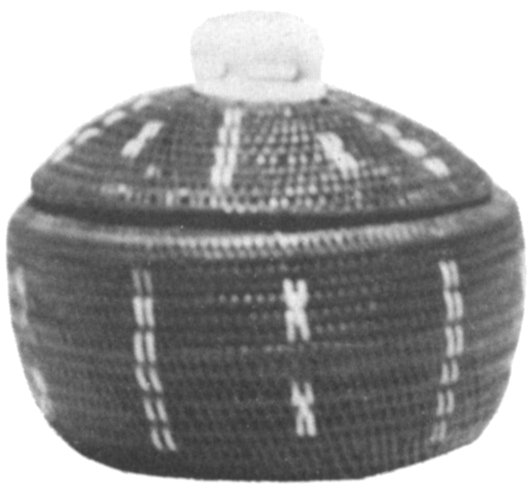
1b
TRINKET
Eskimo
Alaska
Size: 3½″ × 3½″

1c
DECORATIVE
Attu
Aleutian Islands, Alaska
Size: 5″ × 6″
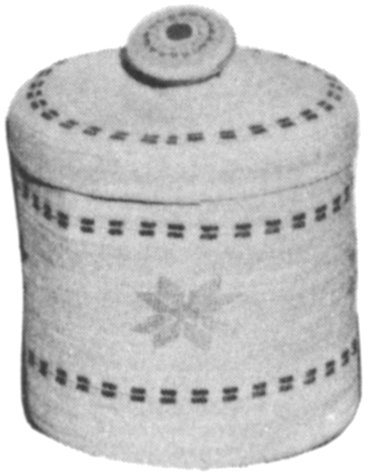
1d
DECORATIVE
Attu
Aleutian Islands, Alaska
Size: 3¼″ × 3¾″

2a
WATER JUG
Chiricahua Apache
New Mexico
Size: 13½″ × 9½″
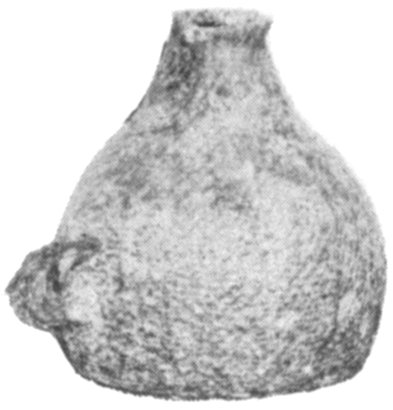
2b
WATER JUG
Havasupai
Arizona
Size: 12″ × 10″
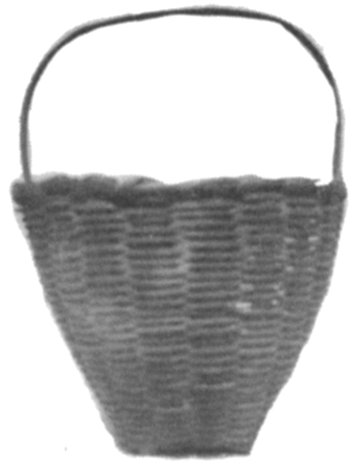
2c
HISTORICAL—UTILITARIAN
Wampanoag
Massachusetts
Size: 6¾″ × 9″
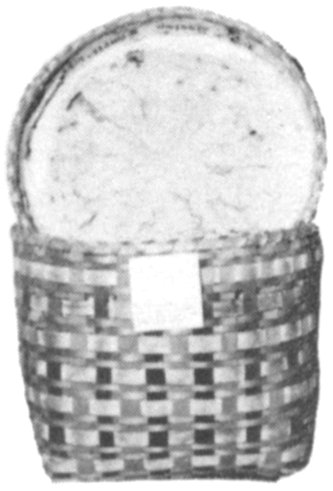
2d
HISTORICAL—UTILITARIAN
Pennacook
Massachusetts
Size: 14½″ × 20″

3a
CRADLE
Pomo
California
Size: 16″ × 12″ × 7″
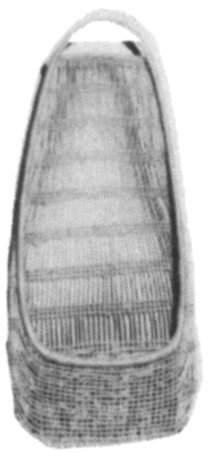
3b
CRADLE
Hoopa
California
Size: 16¾″ × 9½″
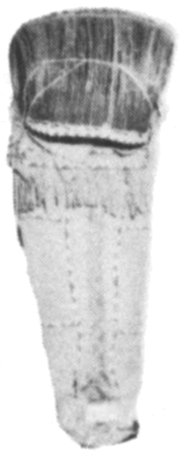
3c
CRADLE
Ute
Colorado
Size: 34″ × 12″

3d
FISHING CREEL
Algonquin
Quebec, Canada
Size: 10½″ × 10½″ × 8½″
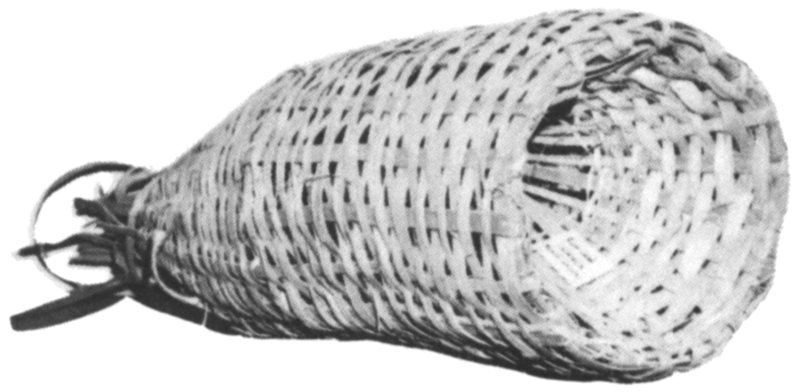
4a
FISH TRAP
Catawba
North Carolina
Size: 64″ × 16″
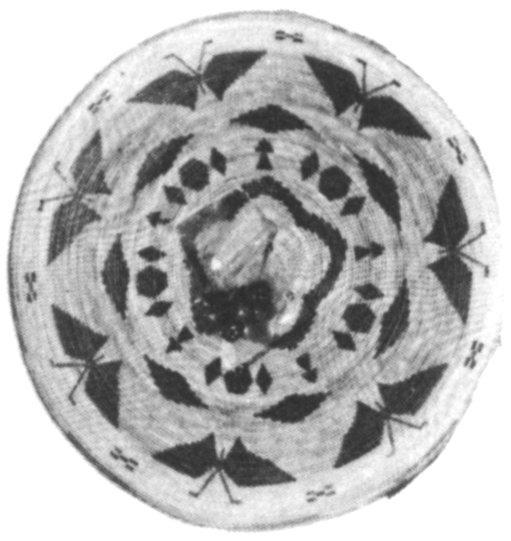
4b
GAMBLING MAT
Pomo
California
Size: 28″ diameter
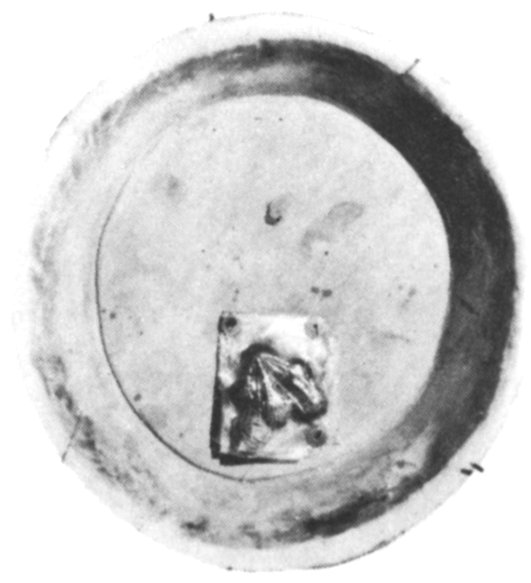
4c
GAMBLING TRAY
Seneca—Cayuga
New York and Oklahoma
Size: 12″ × 3¼″
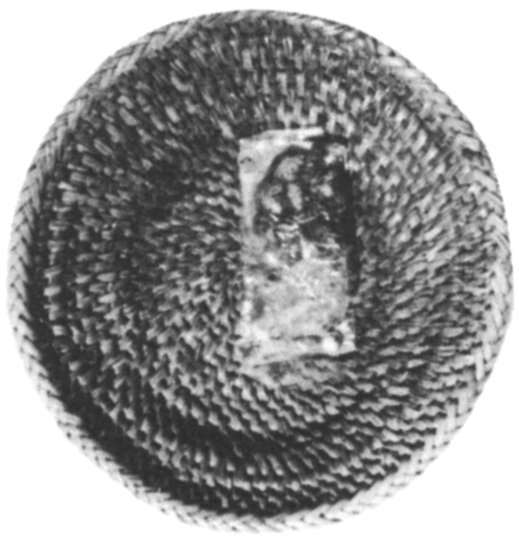
4d
GAMBLING TRAY
Pawnee
Nebraska and Oklahoma
Size: 9″ × 2″

5a
BERRY GATHERING
Yakima
Washington
Size: 20″ × 14½″
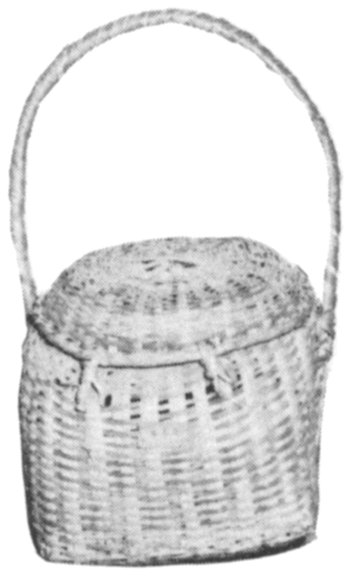
5b
BERRY GATHERING
Choctaw
Mississippi
Size: 10″ × 10″
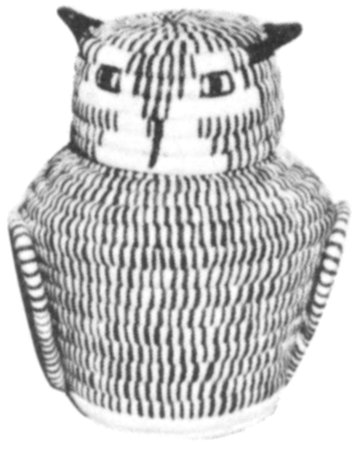
5c
EFFIGY—TRINKET
Papago
Arizona
Size: 8½″ × 7″
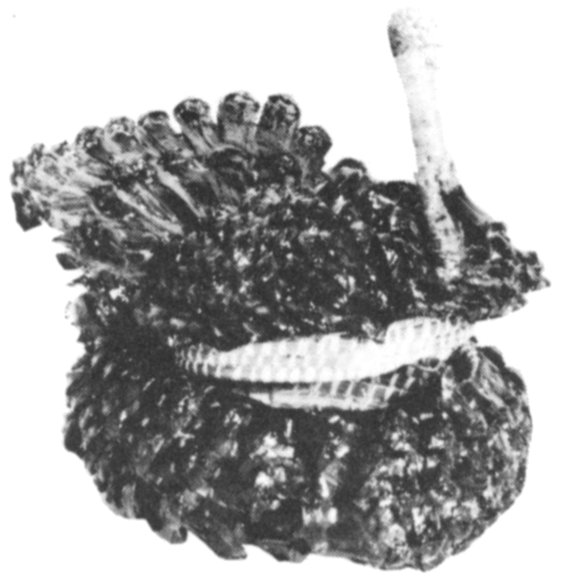
5d
EFFIGY—TRINKET
Alibamu
Alabama and Texas
Size: 6″ × 7″
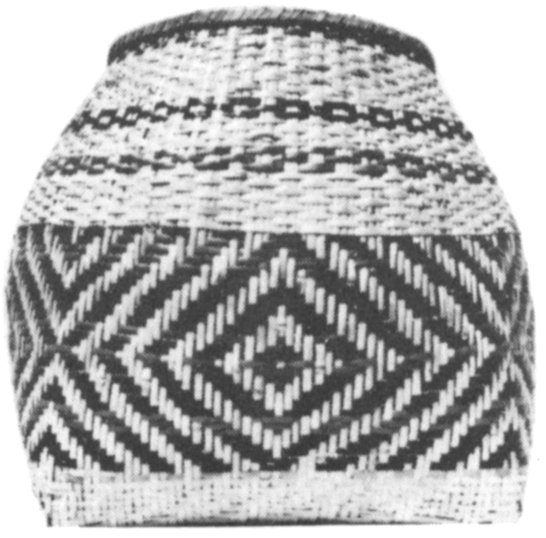
6a
STORAGE
Cherokee
North Carolina
Size: 18½″ × 18″
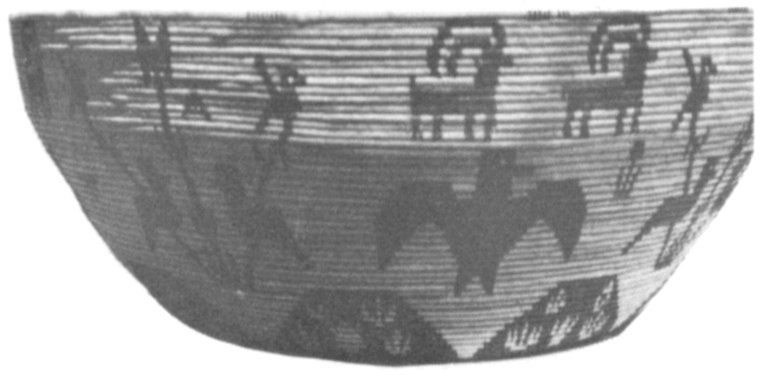
6b
STORAGE
Shoshone—(Panamint)
Death Valley, California
Size: 24″ × 9″

6c
STORAGE
Tonto Apache
Arizona
Size: 29½″ × 19″
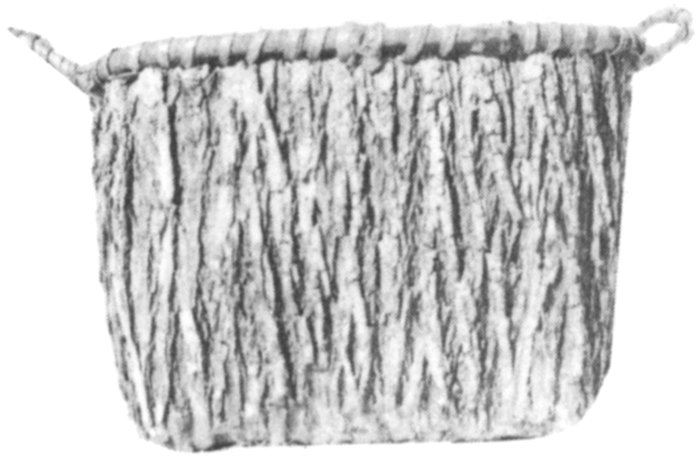
6d
STORAGE
Ottawa
Michigan
Size: 10½″ × 14″ × 10″

7a
STORAGE
Cherokee
North Carolina
Size: 13¾″ × 12″ × 12″
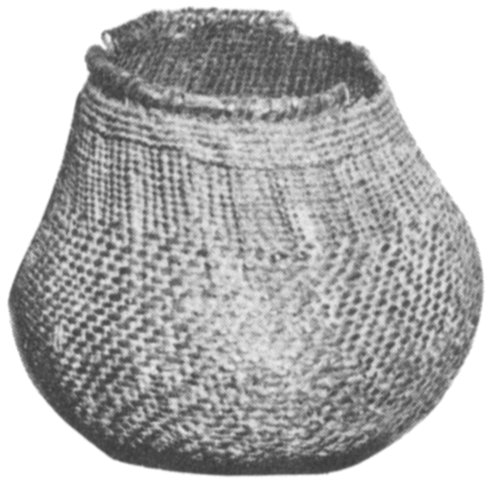
7b
STORAGE
Basket Maker II
New Mexico
Size: 5⅝″ × 4″

7c
STORAGE
Algonquin
Quebec, Canada
Size: 12½″ × 18½″ × 15½″
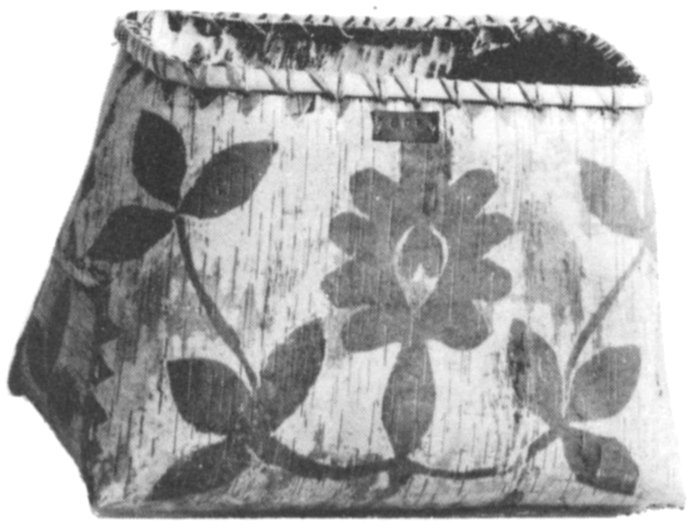
7d
STORAGE
Chippewa
Wisconsin
Size: 17″ × 9″ × 12″
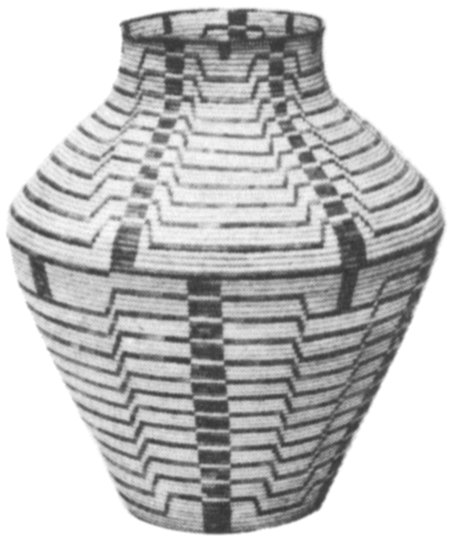
8a
STORAGE
Pima
Arizona
Size: 21½″ × 18″
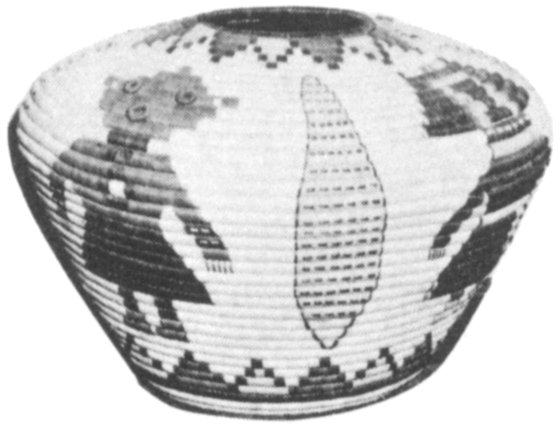
8b
STORAGE
Hopi
Arizona
Size: 13″ × 17″

8c
GATHERING
Chippewa
Wisconsin
Size: 30″ × 20″ × 7½″
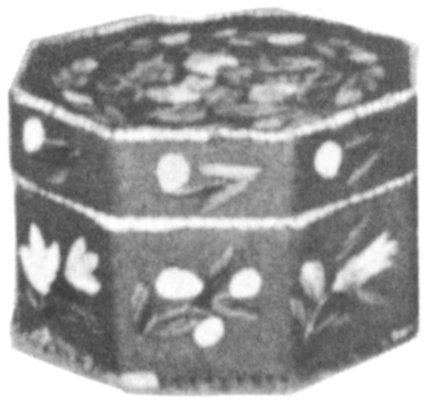
8d
HOUSEHOLD TRINKET
Passamaquoddy—Malecite
Maine
Size: 3″ × 5″
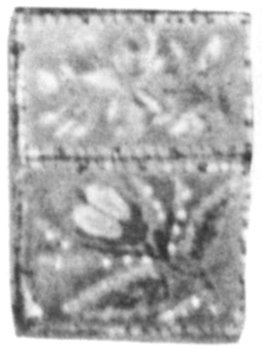
CARD CASE
Huron
Quebec, Canada
Size: 4″ × 2¾″

9a
HARVEST
Cahuilla (Mission)
California
Size: 8½″ × 22″
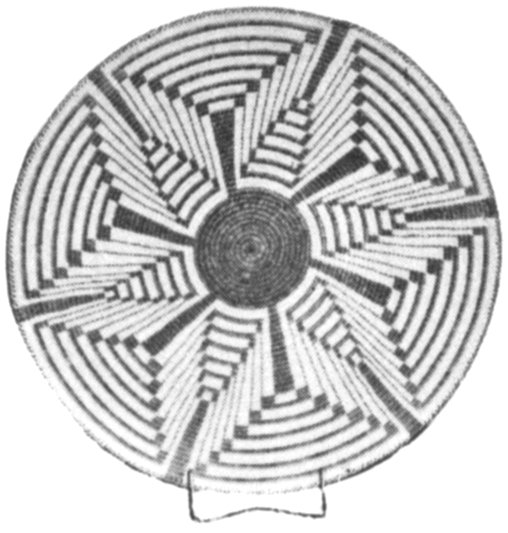
9b
WINNOWING TRAY
Pima
Arizona
Size: 3″ × 19″
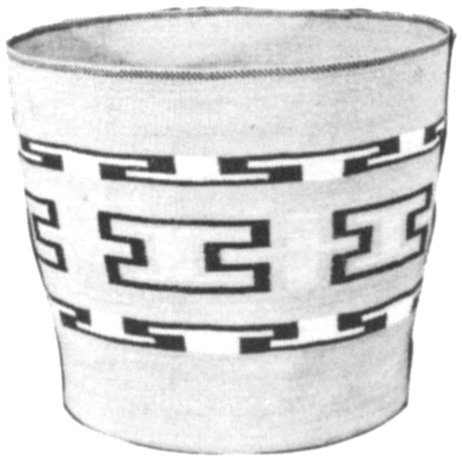
9c
COOKING
Thlinkit
Alaska
Size: 11½″ × 14″
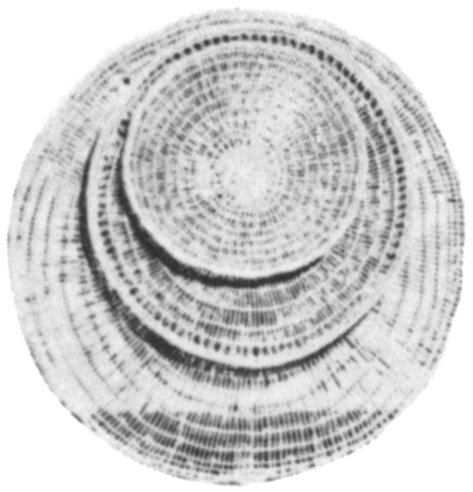
9d
ROASTING
Yurok (2)
California
Size: 2½″ × 10½″ and 3″ × 21½″
Modoc (1)
Oregon
Size: 3½″ × 14½″
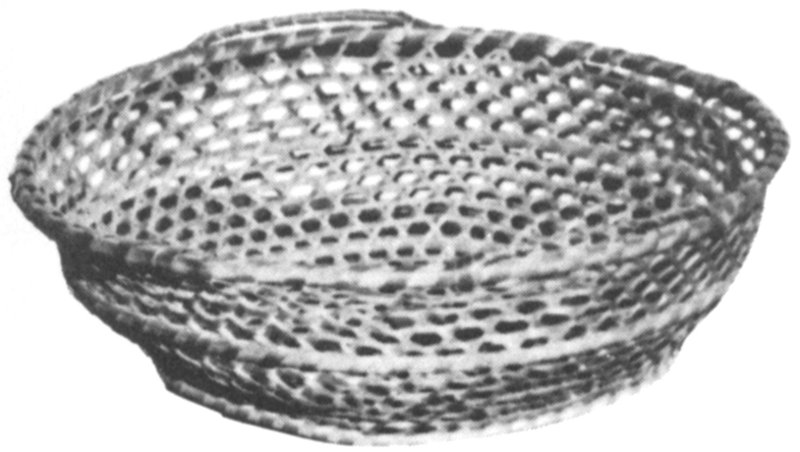
10a
COLANDER
Penobscot
Maine
Size: 5½″ × 11½″
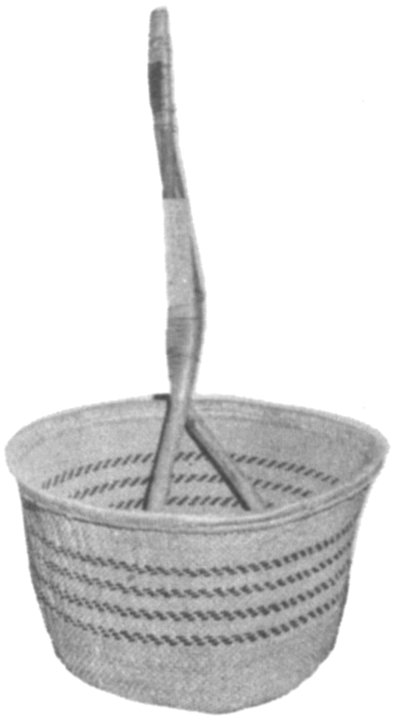
10b
PORRIDGE BOWL
Paiute
California
Size: 8″ × 12″
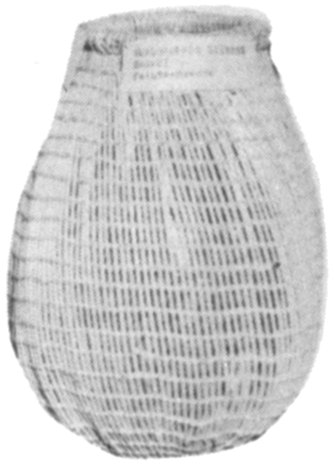
10c
STEWING GRASSHOPPERS
Paiute
California
Size: 12″ × 9″
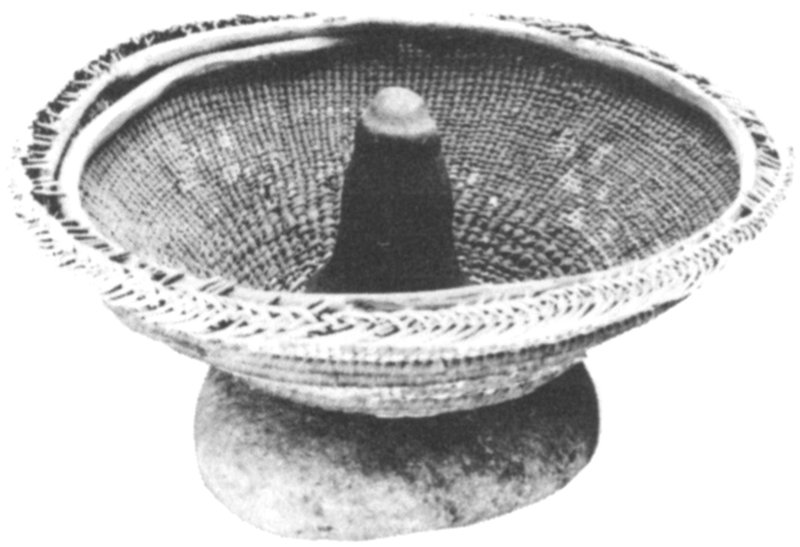
10d
GRINDING TRAY
Hoopa
California
Size: 4½″ × 16½″

11a
MANIOC PRESS
Carib
Guatemala and Venezuela
72″ × 2½″ not expanded
40″ × 4″ expanded (filled)

11b
FOOD BOWL
Mission
California
Size: 5½″ × 15″
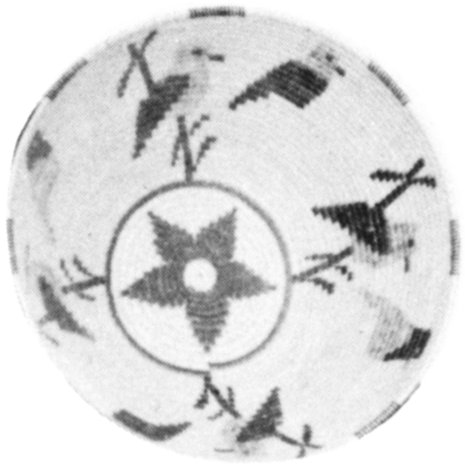
11c
FOOD BOWL
Shoshone (Panamint)
California
Size: 3⅜″ × 7½″

12a
FOOD PLATTER
Cahuilla (Mission)
California
Size: 4½″ × 20″
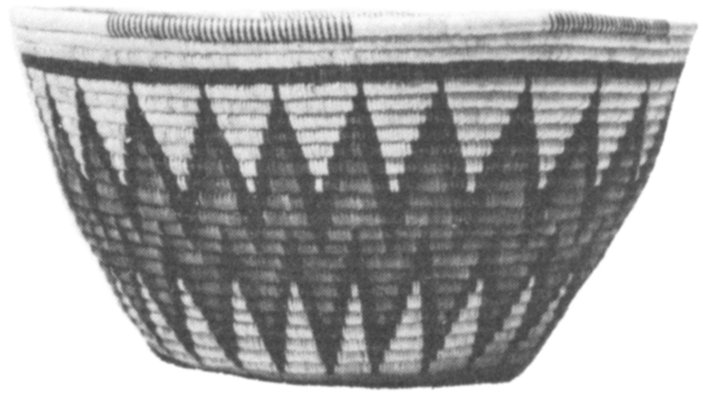
12b
FOOD BOWL
Shoshone (Panamint)
California
Size: 4″ × 8½″
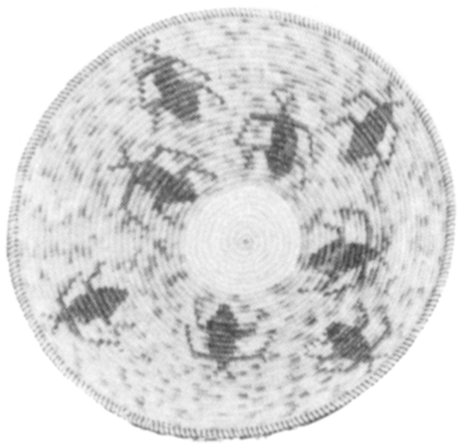
12c
FOOD PLATTER
Chemehueve
Arizona
Size: 3″ × 15″
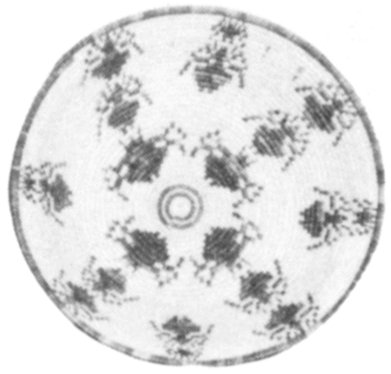
12d
FOOD PLATTER
Yavapai Apache
Arizona
Size: 4″ × 12½″

13a
FOOD PLATTER
Western Apache
Arizona
Size: 4¾″ × 21½″
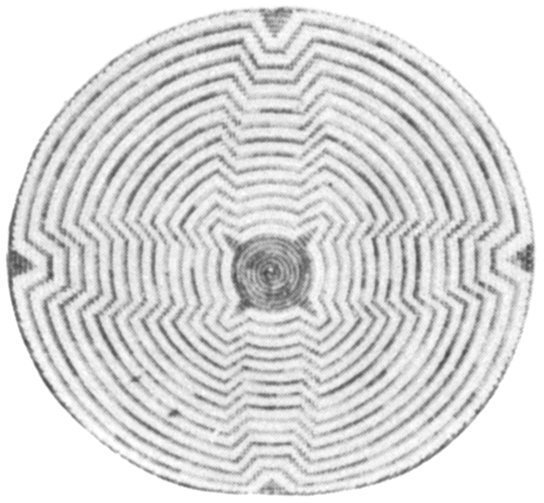
13b
FOOD PLATTER
Papago
Arizona
Size: 2¾″ × 11½″
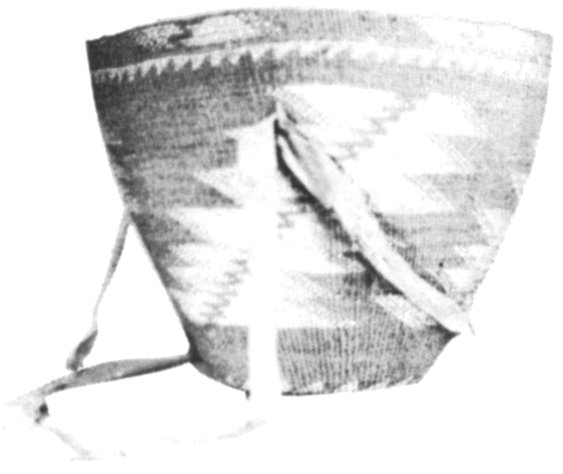
13c
CARRYING (Tump-Line)
Karoc
California
Size: 9¾″ × 13″
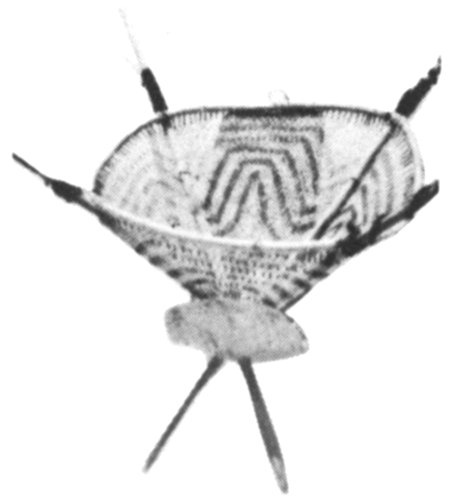
13d
CARRYING
Papago
Arizona
Size: 12″ × 25½″ × 20½″
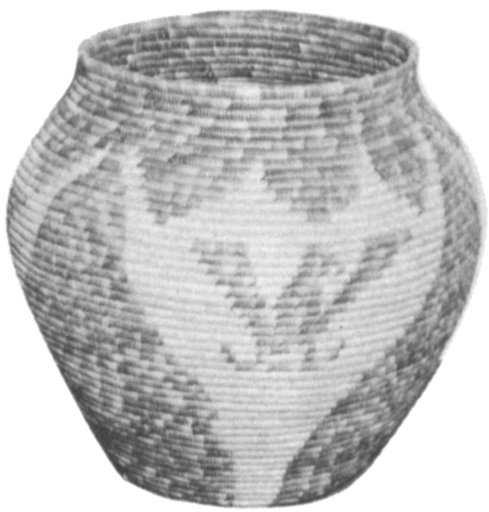
14a
CARRYING (Grasshopper)
Cahuilla (Mission)
California
Size: 14″ × 9″
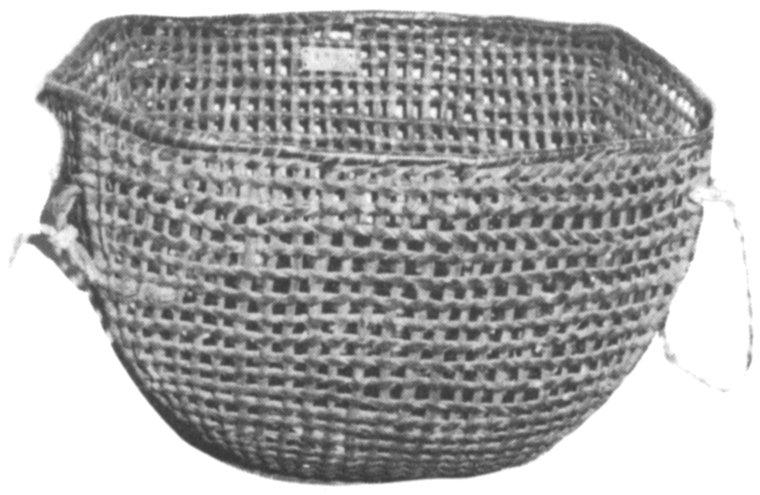
14b
GATHERING (Clams)
Quinault
Washington
Size: 12¾″ × 16″ × 10″
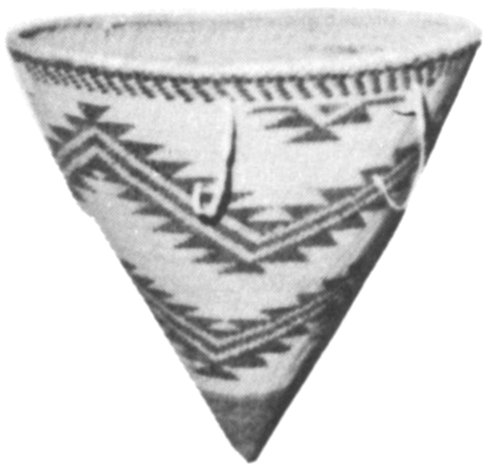
14c
CARRYING
Maidu
California
Size: 29½″ × 19″

14d
CARRYING
Gabrielenos (Mission)
California
Size: 19″ × 25″

15a
CARRYING (Sally Bag)
Umatilla
Oregon
Size: 17½″ × 13½″
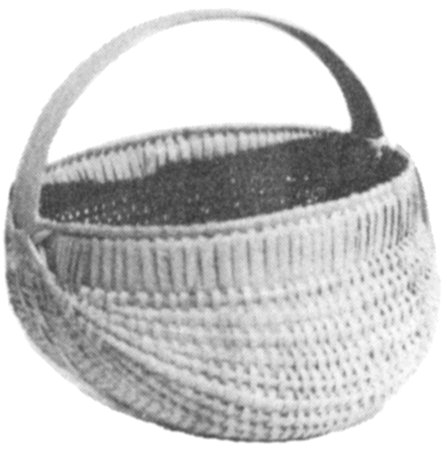
15b
HOUSEHOLD (Farm)
Cherokee
Oklahoma
Size: 6″ × 9½″
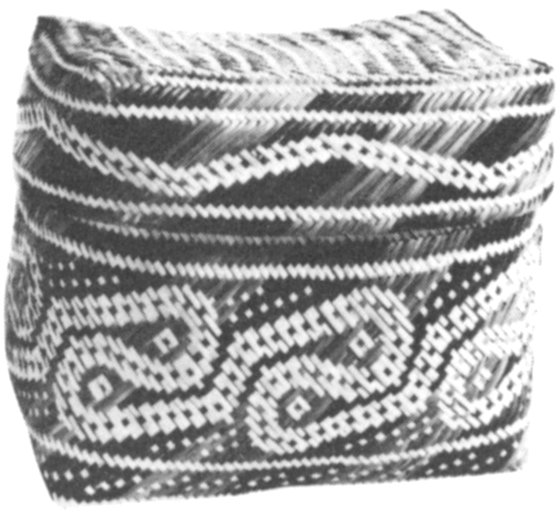
15c
HOUSEHOLD
Chitimacha
Louisiana
Size: 6½″ × 9″ × 6″
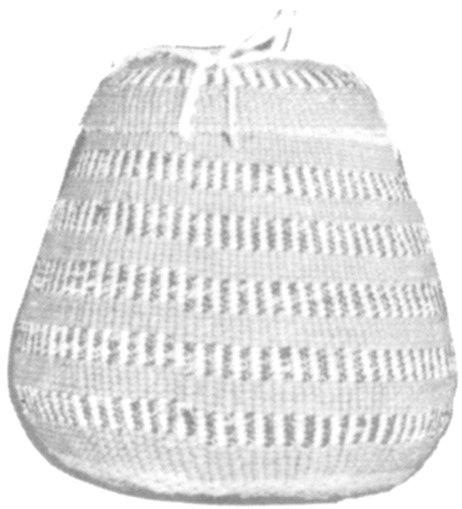
15d
HOUSEHOLD (Tobacco)
Hoopa
California
Size: 4½″ × 4⅜″
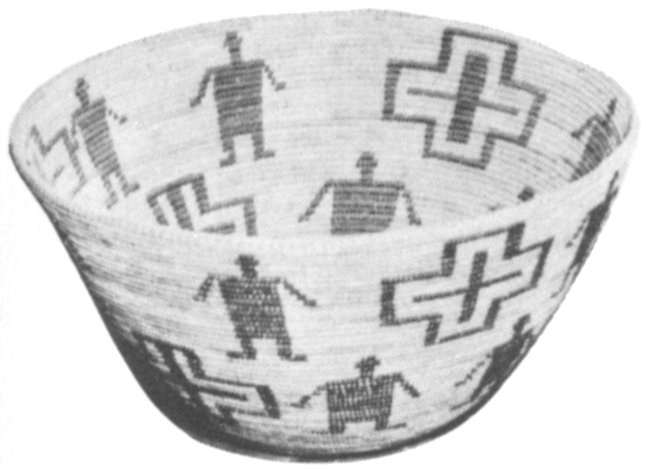
16a
HOUSEHOLD
Yokut
California
Size: 6″ × 12″
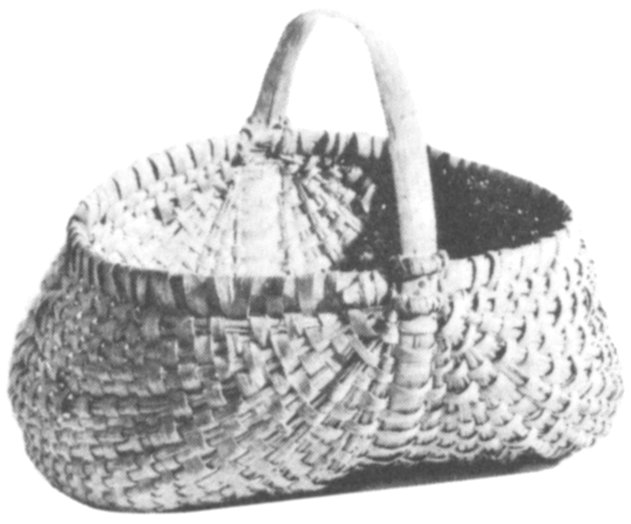
16b
HOUSEHOLD (Farm)
Rappahannock
Virginia
Size: 9½″ × 20″ × 17″

16c
HOUSEHOLD (Wall Pocket)
Choctaw
Oklahoma
Size: 14″ × 12″
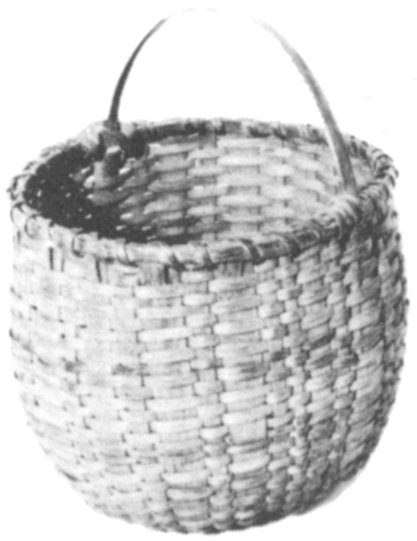
16d
HOUSEHOLD
Cherokee
Oklahoma
Size: 9½″ × 12″

17a
CEREMONIAL
Washoe
Nevada
Circumference 52″
13″ hi, 8″ orifice
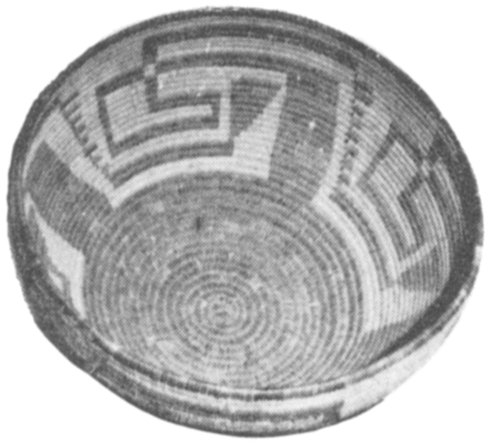
17b
CEREMONIAL (Wine)
Papago
Arizona
Size: 7¼″ × 15½″
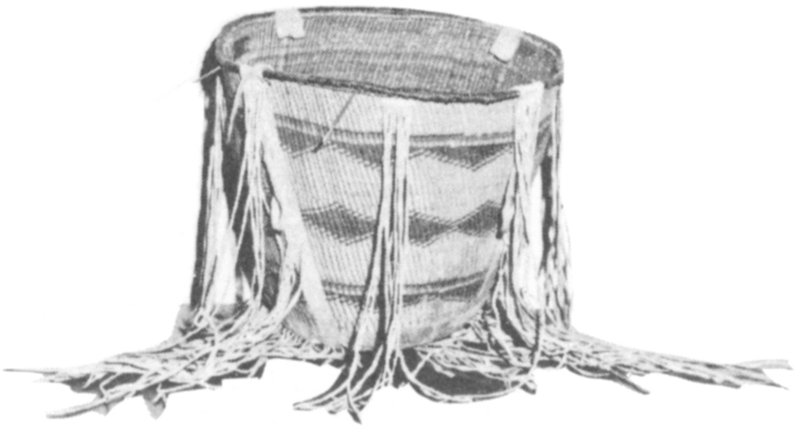
17c
CEREMONIAL (Carrying)
White Mountain Apache
Arizona
Size: 13¾″ × 14″ × 15″
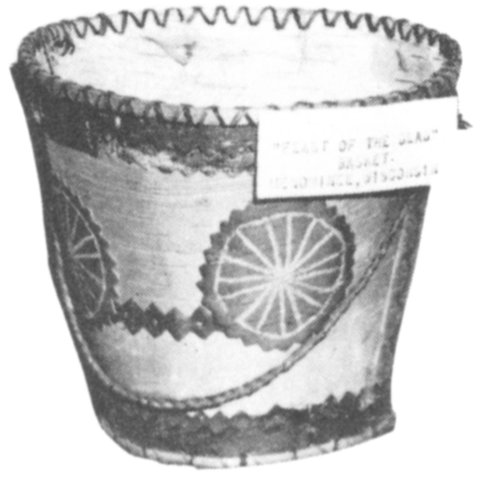
17d
MOURNING BOWL
Menominee
Wisconsin
Size: 7″ × 8″
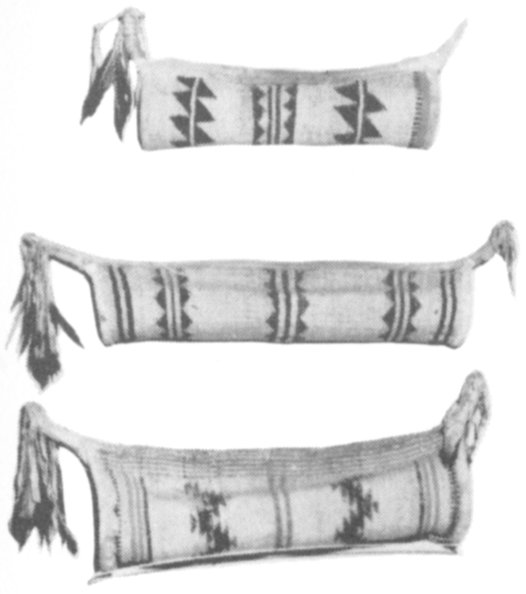
18a
CEREMONIAL (Jumping Dance)
Hoopa
California
Top: 15″ × 3½″
Middle: 18″ × 4½″
Bottom: 20″ × 5½″

18b
CEREMONIAL (Wedding)
Pomo
California
Size: 5⅝″ × 12″
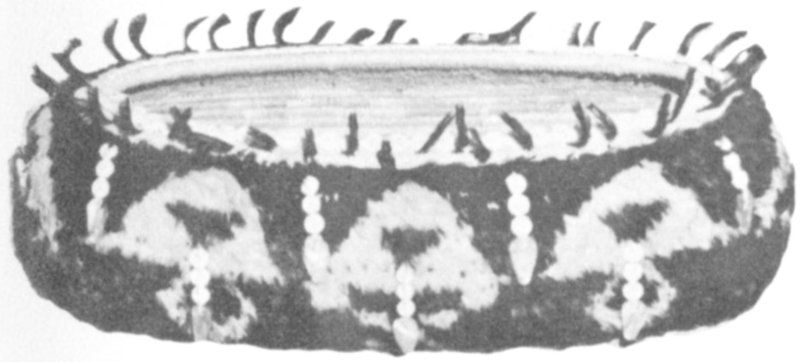
18c
MORTUARY
Pomo
California
Size: 5″ × 14″
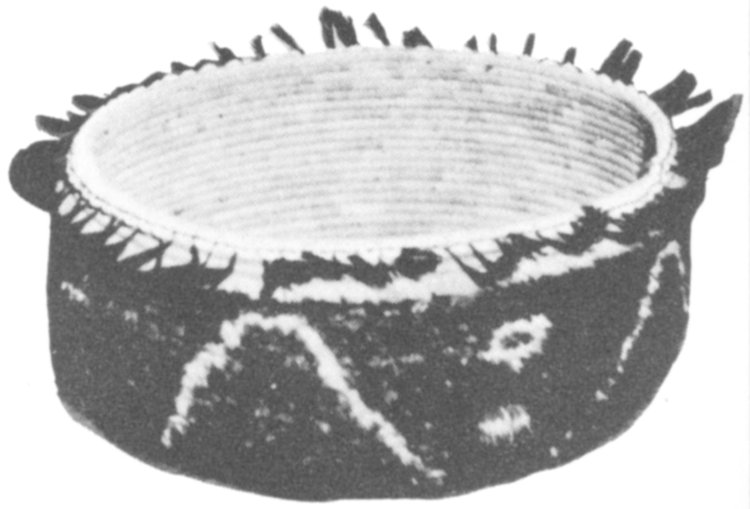
18d
MORTUARY
Pomo
California
Size: 5″ × 9½″

19a
CEREMONIAL (Wedding)
Hopi
Arizona
Size: 2½″ × 15″

19b
CEREMONIAL (Wedding)
Navajo
Arizona
Size: 4″ × 13″
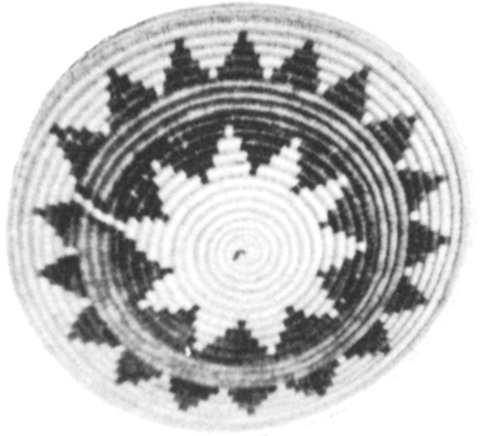
19c
CEREMONIAL (Medicine Tray)
Paiute
Arizona
Size: 3″ × 14½″
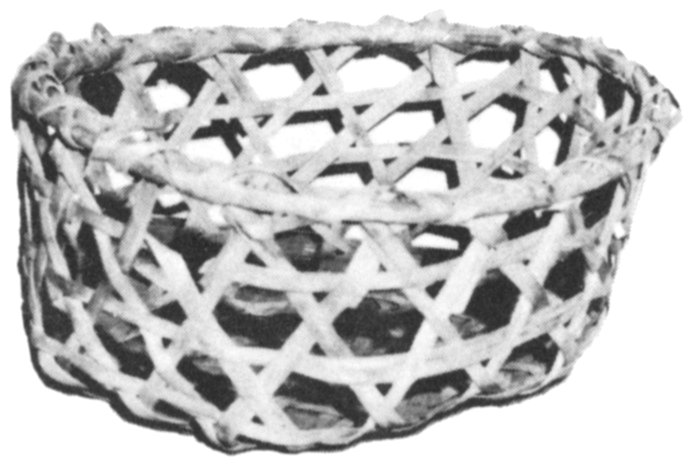
19d
RINSING (Clothes)
Niantic
Connecticut
Size: 6″ × 11″ × 11″

SOYAL INITIATION CEREMONY
(Prayer Offering Ceremony)
Hopi
Arizona

BLOW GUN, QUIVER and DART
Cherokee
North Carolina
Reprint from Philbrook Brochure, 1952
by Clark Field
The purpose that a foreword serves to the reading public is ostensibly to express its writer’s endorsement of the material presented and of the mode of treatment. In this instance the purpose is heartily avowed. The monograph in hand forms a contribution to the series of studies being pursued widely among scholars whose aim is to piece together portions of the picture of culture of the Indians of the Southeast. Our knowledge of the culture properties of native tribes in any area where their development has been going on for centuries in their original seats comes necessarily by gradual steps. These may seem disconnected in the minds of laymen who are in haste to see the whole story completed. Perhaps only the pioneer investigator knows how long and intimately a people must be studied by dwelling in their midst before their ways of life become clear enough to be understood and discussed. Collections of data, historical, descriptive and functional, have to be made and preserved in the form of notes and actual specimens. When these ends are accomplished, the picture of tribal life takes definite shape, and another gap in the history of a people is closed. These are the requirements for carrying on in a somewhat new undertaking in the line of history, namely ethno-history.
Studies of a people’s physical structure, their psychology, language, religion and government contribute their share. On the material side their crafts developed to supply economic needs and the art involved in the crafts themselves must be illustrated with accumulations of specimens. These requirements the author of the following study has had well in mind for a considerable space of time, and he has treated them with conservative judgment and a regard for their implications with botany and ecology. Such remarks applied to the paper constitute the ethnologist’s endorsement.
It is a splendid thing for man of the present to take time to stabilize his mind to contemplating the achievements of tribes inhabiting our continent as a prologue to the affairs of the present. Where is the brash critic to persist in the claim that the natives of America have no original elements of “civilization” either from the early or late past, or in the present? The Cherokee have provided an answer. Contemporary literature has amassed the evidence nor alone in the series of volumes from the University of Oklahoma Press, but in prose and poetry known throughout the nation. It offers a compendious chapter in the epic of America. Each additional study adds a paragraph of importance to the whole.
The study to follow contributes a detail of existing knowledge of the art-crafts of the Cherokee. As such it will prove to be another source reference to the Cherokee way of life in art and its expression in concrete form. The utilities have been and still are to Indians a means of finding outlet for their aesthetic urges. Art and crafts are merged in the output. Other fields lie open for further attempts to perform its functions in national life by issuing successive publications dealing with its cultural material, thus laying foundations for that basic teaching we fondly call Americanism.
FRANK G. SPECK Department of Anthropology, University of Pennsylvania Philadelphia, Pennsylvania 1952
The association of root-runner basket forms in America would show a number of instances of use of a “Rod” as a one rod foundation for coiled baskets occurring originally in Arizona, Colorado, New Mexico and on the plains.[1] This technologically simple form of basket building material has implications bearing upon the age and area theory that challenges attention on a wider scale. Apart from the coiling process, a single rod construction appears in the Southeast in wicker work. What conclusions a broader study of single rod basketry (to which class the root runner series belongs) in any of its constructional forms, whether in coiling or wicker work, would lead to is quite beyond the purpose of this article.
It is the intent of the writer to record a simple phase of basketry technique in the southern middle Atlantic slope and the northern part of the south and southeast area, as it applies to the Cherokee of the North Carolina highlands and of Oklahoma. In these areal habitats the two subdivisions of the tribe make use of three diverse plant types, the use of which in basketry construction in some districts does not overlap or coincide. In Carolina an earlier root-runner style has either passed out of memory or never existed among the Cherokee Indians, but came in later through acculturative changes. As far as has been ascertained, all fine root runner fibers used in the making of Indian baskets belong to two family groups, the botanical names of which are Caprifoliceae and Crataegus.
To the first family group belong:
To the second family belong:

The Rappahannock Indians of Virginia make a basket of Japanese honeysuckle root runners of a wicker type weave which is crude in weaving technique in comparison with baskets from North Carolina. (Rappahannock of Virginia.) Quoting Dr. Speck, “The art was revived by some of the women in 1922, when the Indian Association was formed. Susie and Lizzie Nelson, old Bob Nelson and other Rappahannock Indians made these baskets at that time. Chief Otto Nelson, his wife Susie, and Lizzie Nelson remember that when they were young about 1890, their grandmother Sallie Ronnie, who was then about 60 years old, had a honeysuckle sewing basket shaped like an oval bowl, similar in weave to the baskets mentioned above.
“There is a native local, variety of Red Honeysuckle (Lonicera sempervirens) in Virginia which is not a ground runner but clings for six feet or so to trees and fences; it is finer stemmed than the Japanese variety and Indian women of the Rappahannock tribe have agreed to weave with it. All honeysuckle runners are kept soaked in water to preserve their pliability for weaving. They can be gathered and woven at any time of the year if treated in this manner.”
As far as known no other fine root runner is used for basket weaving by the Indians of this state, although other fine root runners such as Devil’s Shoestring and London Pride grow there. Comments on honeysuckle wicker-weave baskets among the Mattaponi Indians of Virginia are made by Dr. Frank Speck in his book “At Mattaponi,” in which he speaks of the girls making baskets of honeysuckle stems, meticulously neat and with a technique suspiciously European in detail. We cannot be too sure that something like this did not exist before as many references to baskets of various forms made in the early days are encountered.[4] The Pamunkey Tribe, living on a reservation ten miles south of Mattaponi, have used honeysuckle runners for over twenty years. In both bands the details of form and weave are identical, and the historical circumstances may also be.
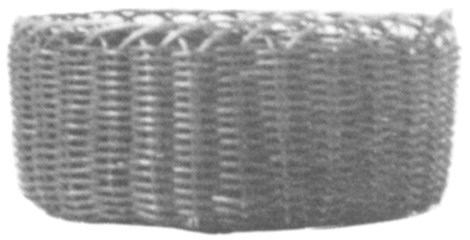
The Cherokee Indians of North Carolina used Japanese honeysuckle in basket weaving as early as 1880, when it was introduced by a Cherokee woman named Arizona Blankenship who had been educated at Hampton Institute, Virginia. It is interesting to note that the Cherokee Agency Indian School was founded at Cherokee, North Carolina, that same year.
In January, 1943, Dr. Speck made an extensive trip into the hill country around Cherokee, North Carolina, visiting the old conservative Cherokee Indians of that region. He learned from the old people that honeysuckle basket weaving was not an original Cherokee Indian art. Making inquiry into their history of basket weaving, he could find no evidence of their use of hawthorne (Crataegus) although it is native to that state, or any historical evidence of the use of any other fine root runners. It is possible, of course, that the Hawthorne runners could have been used by other Indian bands in other parts of the state but so far it is not known, notwithstanding the fact Dr. Speck has spent many years of study of Cherokee Indian basketry in North Carolina.[5] Cane and oak splints were used chiefly by the Cherokee in basket weaving and the use of Japanese honeysuckle was undoubtedly a later addition to their culture. An illustration of one of the earliest known types of honeysuckle weave is shown in the Cherokee of North Carolina plate. This basket has no foundation to support the fine root runner fibers although most of their baskets made of honeysuckle runners do have foundations of oak splints. As far as is known no double weaving of fine root runner baskets was done by the Cherokee of this state.

The Cherokee of Oklahoma used buckbrush (Symphoricarpos Orbiculatus) in making fine root runner baskets and it appears after careful study and extensive inquiry, that this type of basket weaving may have originated among the Indians of Oklahoma. This conclusion is based on many years of collecting baskets from Cherokee Indians in every part of the old Cherokee nation. Interviews with older basket-making women were held through interpreters and it was clearly established that basket making from honeysuckle was not known to them or to their mothers or grandmothers who had lived in Georgia and North Carolina before their removal in 1938 to Oklahoma. The only type of weaving known to them before coming to Oklahoma was the cane and oak-splint weaving. From such interviews these facts could be traced back to as early as 1850. They were certain that the earliest baskets made by their grandparents were out of buckbrush and oak splints; no cane or honeysuckle was used in the northern part of the Cherokee nation.
In the Spavinaw hills country of the northern part of the Cherokee nation the Indians used only buckbrush runners as cane does not grow in this section. In the southern part of the nation, in the vicinity of Gore and Weber Falls, cane grows and is used almost exclusively in basket weaving. In the locality of Tahlequah and Stillwell both cane and buckbrush weaving is done. The Cherokee of this region make both a double and single wicker weave basket of buckbrush runners and no foundation is used in either type although each is strong and serviceable. All of their fine root runner baskets (buckbrush) are a wicker type of weave of unexcelled technique. The double weave basket made by Lucy Mouse (shown in the Oklahoma example) is a splendid specimen of fine weaving—a strong durable basket. The dye used in this basket is walnut stain from boiled walnut hulls.
The buckbrush runners are pulled in the fall of the years and after drying two or three weeks are boiled to remove the bark. The fibers remain flexible enough for weaving all winter which is the basket weaving season.
The shapes were formerly market baskets, fruit trays, egg baskets and storage baskets, some of which were used by them as long as fifty years ago. Twenty-five years ago vegetable dyes were used for coloring but today commercial dyes are largely used; the baskets are made, as a rule, for sale, and show considerable white influence.
—Clark Field
I was born in Dallas, Texas, on January 6, 1882.
I first became interested in the art work of the Indians while working as a reporter for an Oklahoma daily newspaper in 1900, at which time I covered the opening for settlement of the Kiowa, Comanche and Apache Indian reservations in southwest Oklahoma. After two years of study (1903-1904) at the University of Oklahoma, I became a traveling salesman and remained in that profession until 1917 when I went into business for myself (retired from business in 1957). About 1918 I became actively interested in Indian pottery and basketry and started my collections. Since that time, Mrs. Field, my daughter Dorothy Field Maxwell (Mrs. Gilbert S.), and I have traveled more than one hundred and twenty five thousand miles collecting in the United States, Canada, Alaska, Mexico, Central and South America.
To date (1964) we have spent 46 years in trying to collect authentic specimens of baskets made for actual use by all basket-making tribes (no tourist specimens are included). Intent upon maintaining the highest possible quality throughout the collection, I have always insisted upon acquiring the finest representative basket for its particular tribe or use.
The collection is completely catalogued and photographed and has been given to the Philbrook Art Center of Tulsa, Oklahoma, where it is on exhibition. The collection has been rated by members of the Indian Arts and Crafts Board, and by members of other museums, as the most comprehensive in the United States for its beauty of specimens and unusual method of display.
Clark Field
| Page | Plate | |
|---|---|---|
| Ahcacon | 25 | 3a, 3b, 3c |
| Aleut | 22, 23 | 1c, 1d |
| Algonquin | 19 | 3d, 7c |
| Alibamu | 18 | 5d |
| Apache | 3 | 6c |
| Chiricahua | 5, 15 | 2a |
| San Carlos | 5 | |
| Tonto | 5, 14 | 6c |
| Western | 5 | 13a |
| White Mountain | 12, 14 | 17c |
| Yavapai | 4, 5 | 12d |
| At the Landing of the Pilgrims | 7 | |
| Attu | 22, 23 | 1c, 1d |
| Autobiography | 31 | |
| Basket: | ||
| Baby Cradle | 24, 25 | 3a, 3b, 3c |
| Bag, Corn Husk | 18 | 15a |
| Baleen | 21, 22 | 1b |
| Berry | 15, 19 | 5a, 5b |
| Birchbark | 19, 21 | 3d, 7c, 7d, 8c |
| Bird Cage | 3 | |
| Boiling | 17 | 9c |
| Bowl | 4, 15, 23 | 8b, 10b, 11b, 11c, 12b |
| Canoe | 19 | 7c |
| Burden | 16, 17 | 9a, 13c, 13d, 14a, 14c, 14d |
| Carrying | 12, 16, 17 | 9a, 13c, 13d, 14a, 14c, 14d, 17c |
| Ceremonial | 6, 8, 9, 10, 11, 12, 13 | 17a, 17b, 17c, 18a, 18b, 18c, 18d, 19a, 19b, 19c, 20 |
| Clam | 4 | 9c, 14b |
| Colander | 3 | 10a |
| Cooking | 3, 19 | 5a, 9c |
| Corn Husk | 18 | 15a |
| Effigy | 18 | 5c, 5d |
| Coming Out Dance | 12, 13 | 17c |
| 33 | ||
| Egg | 30 | |
| Feathered | 8, 12 | 18b, 18c, 18d |
| Fishing Creel | 19 | 3d |
| Fish Trap | 3 | 4a |
| Food Bowl | 4, 15 | 8b, 10b, 11b, 11c, 12b |
| Gambling | 23 | 4b, 4c, 4d |
| Gathering | 4, 15, 19 | 5a, 5b, 8c, 14a, 14b |
| Grasshopper | 16 | 10c, 14a |
| Harvest | 4, 16 | 9a |
| Historical | 7, 15 | 2c, 2d, 5b |
| Household | 14 | 15b, 15c, 15d, 16a, 16b, 16c, 16d |
| Ideas Copied | 3 | 4a, 10a |
| Initiation Ceremony | 10 | 20 |
| Jumping Dance | 9 | 18a |
| Kachina | 15 | 8b |
| Manioc Press | 24 | 11a |
| Market | 30 | |
| Miniatures | 20 | |
| Moose Hair | 21 | 8d |
| Mortuary | 8 | 18c, 18d |
| Mourning Bowl | 9 | 17d |
| Plaque | 10, 11 | 19a, 20 |
| Porridge Bowl | 4 | 10b |
| Quilled | 20 | 1a |
| Quiver | 25 | 21 |
| Rinsing | 4 | 19d |
| Roasting Tray | 18 | 9d |
| Root Runner | 26, 27, 28, 29, 30 | |
| Sally Bag | 18 | 15a |
| Seed Container | 13 | 7b |
| Soyal | 10 | 20 |
| Squash Blossom | 19 | 9b |
| Stewing | 16 | 10c |
| Storage | 3, 4, 13, 14 | 6a, 6b, 6c, 6d, 7a, 7b, 7c, 7d, 8a, 8b |
| 34 | ||
| Tray | 4, 18, 19, 23 | 4d, 8c, 9b, 9d, 10d |
| Trinkets | 18, 21 | 1b, 5c, 5d, 8d |
| Tump-line | 16 | 13c |
| Unique Designs | 4 | 6b, 10d, 11b, 11c, 12a, 12c, 12d, 15c, 16c, 19d |
| Utilitarian | 7 | 2c, 2d |
| Wall Pocket | 4 | 16c |
| Watertight | 15, 17 | 2a, 2b, 9c |
| Water Bottle | 15 | 2a, 2b |
| Wedding | 10, 11, 12 | 18b, 19a, 19b, 19c |
| Whalebone | 21, 22 | 1b |
| Wild Rice | 19 | 8c |
| Wine | 8 | 17b |
| Winnowing | 19 | 9b |
| Basketry | ||
| Aleut Island | 22, 23 | 1c, 1d |
| Birchbark | 19, 21 | 3d, 7c, 7d, 8c, 8d |
| Early | 3 | |
| General | 1, 2 | |
| Root Runner | 26, 27, 28, 29, 30 | |
| Western Apache | 5 | 13a |
| Basket Makers | 13 | 7b |
| Blow Gun | 25 | 21 |
| Bluff Dwellers | 3 | |
| Bottle | 15 | 2a, 2b |
| Bowl | 4, 15, 23 | 4c, 8b, 10b, 11b, 11c, 12b |
| Buckbrush | 30 | |
| Box | ||
| Canoe | 19 | 7c |
| Storage | 19 | 7c, 7d |
| Household | 20 | 1a |
| Trinket | 21 | 8d |
| Catawba | 3 | 4a |
| Central America | 24 | 11a |
| 35 | ||
| Cacique | 10 | |
| Cahuilla | 4, 16 | 9a, 12a, 14a |
| Carib | 24 | 11a |
| Chemehueve | 4 | 12c |
| Cherokee | 1, 14, 16, 25, 26, 27, 29, 30 | 15b, 16d, 21 |
| Cheyenne | 23 | |
| Chippewa | 19, 20 | 1a, 7d, 8c |
| Chiricahua | 5, 15 | 2a |
| Chitimacha | 4, 14 | 15c |
| Choctaw | 4, 15 | 5b, 16c |
| Cochiti | 3 | |
| Coming Out Dance | 12, 13 | 17c |
| Decoration | ||
| False Embroidery | 18 | 15a |
| Feather | 8, 12 | 18b, 18c, 18d |
| Imbricated | 19 | 5a |
| Moose Hair | 21 | 8d |
| Painted | 7 | 2d |
| Quilled | 20 | 1a |
| Dotsolalee | 6, 7 | 17a |
| Effigy | 18 | 5c, 5d |
| Embroidery, Moose Hair | 21 | 8d |
| Eskimo | 21, 22 | 1b |
| Feathered | 8, 12 | 18b, 18c, 18d |
| Feast of the Dead | 9 | 17d |
| Frazier River | 24 | |
| Gabrielenos | 16 | 14d |
| Gambling Devices | 23 | 4b, 4c, 4d |
| Grasshopper | 16 | 10c, 14a |
| Gum Covered | 15 | 2a, 2b |
| Havasupai | 15 | 2b |
| Honeysuckle | 1, 27, 28, 29, 30 | |
| Historical | 7 | 2c, 2d |
| Hoopa | 4, 9, 14, 24 | 3b, 10d, 15d, 18a |
| Hopi | 2, 10, 15, 24 | 8b, 19a, 20 |
| 36 | ||
| Houma | 25 | |
| Huron | 21 | 8d |
| Imbricated | 19 | 5a |
| Karoc | 16 | 13c |
| Kiaha | 17 | 13d |
| Kiva | 10 | |
| Klamath | 23 | |
| Mattaponi | 28 | |
| Malecite | 21 | 8d |
| Maidu | 16 | 14c |
| Menominee | 9 | 17d |
| Miniatures | 20 | |
| Mission | 4, 16 | 9a, 11b, 12a, 14a, 14d |
| Modoc | 18 | 9d |
| Mono-Paiute | 24 | |
| Nahwehteete | 8 | |
| Navajo | 10, 15 | 19b |
| Niantic | 4 | 19d |
| Ottawa | 13 | 6d |
| Paiute | 4, 10, 16 | 10b, 10c, 19c |
| Papago | 2, 8, 17, 18 | 5c, 13d, 17b |
| Pamunkey | 28 | |
| Panamint | 4 | 6b, 11c, 12b |
| Passamaquoddy | 21 | 8d |
| Pawnee | 23 | 4d |
| Pennacook | 7 | 2d |
| Penobscot | 3 | 10a |
| Pilgrims | 7 | 2c |
| Pima | 1, 19 | 9b |
| Platter | 4 | 12a, 12c, 12d |
| Plaques | 10, 11 | 19a, 20 |
| Pomo | 8, 12, 23, 24 | 3a, 4b, 18b, 18c, 18d |
| Porcupine Quills | 20 | 1a |
| Pueblo | 13, 24 | 7b |
| Quileutes | 16 | |
| 37 | ||
| Quill Decoration | 20 | 1a |
| Quinault | 4 | 14b |
| Quiver | 25 | 21 |
| Rappahannock | 14, 28 | 16b |
| Rinsing Basket | 4 | 19d |
| Root Runner Basketry | 26, 27, 28, 29, 30 | |
| San Carlos | 5 | |
| Seneca-Cayuga | 23 | 4c |
| Shoshone | 4 | 6b, 11c, 12b |
| Soyal | 10 | 20 |
| Specimens No Longer Made and Why | 3 | 6c, 9c |
| Speck, Frank G. | 26, 28, 29 | |
| Symbolic Designs | 5 | 12b |
| Thlinkits | 17 | 9c |
| Tray | 4, 18, 19, 23 | 4d, 9b, 9d, 10d |
| Tonto | 5, 14 | 6c |
| Umatilla | 18 | 15a |
| Ute | 24, 25 | 3c |
| Vanishing Indian | 4 | |
| Wampanoag | 7 | 2c |
| Whalebone | 21, 22 | 1b |
| White Mountain Apache | 12, 14 | 17c |
| Wickiup | 16 | |
| Washoe | 6, 7 | 17a |
| Western Apache | 5 | 13a |
| Yakima | 19 | 5a |
| Yavapai Apache | 4, 5 | 12d |
| Yuki | 27 | |
| Yokut | 14 | 16a |
| Yurok | 18 | 9d |
| Zuni | 16 | |